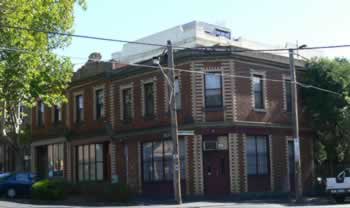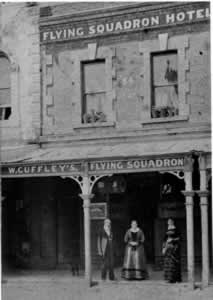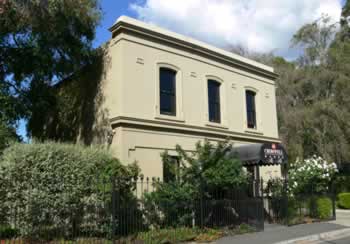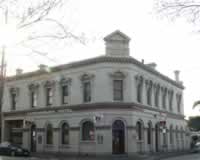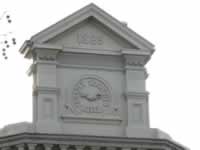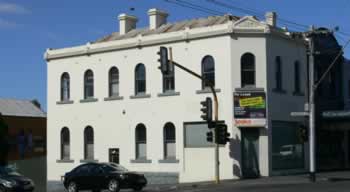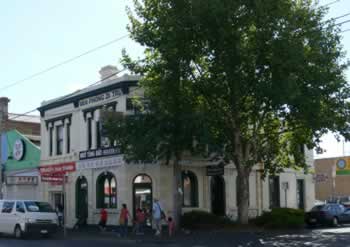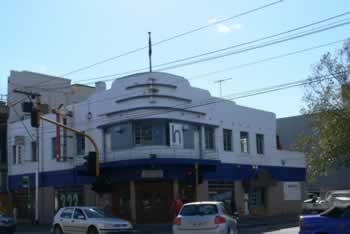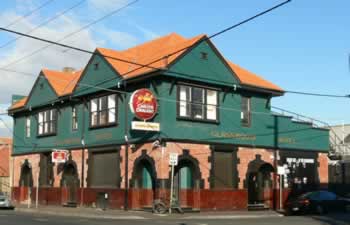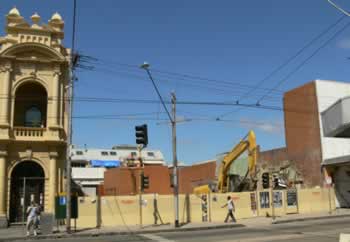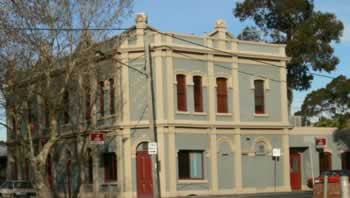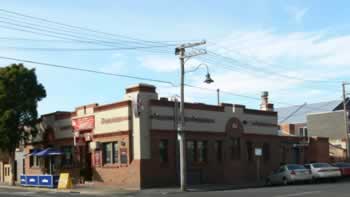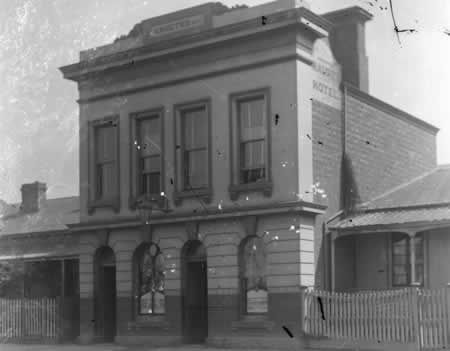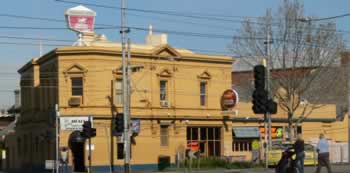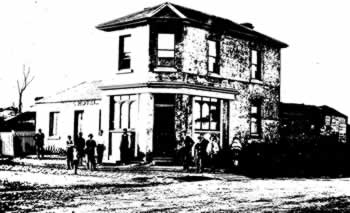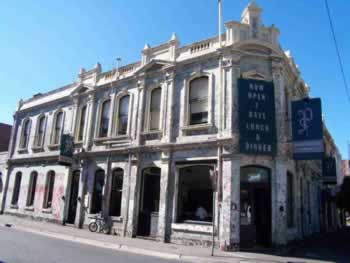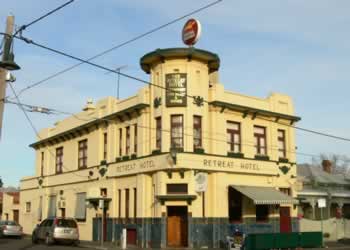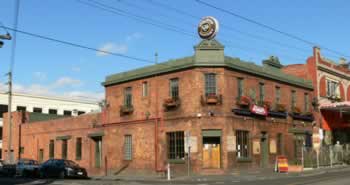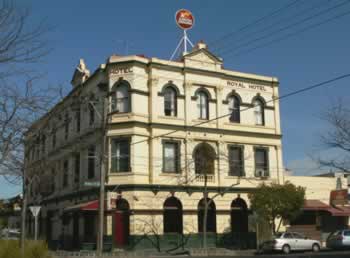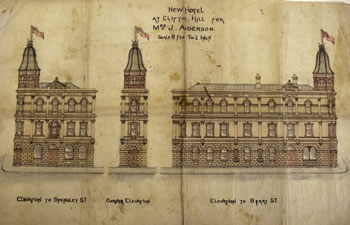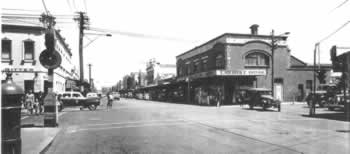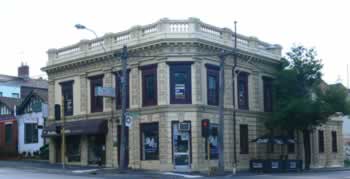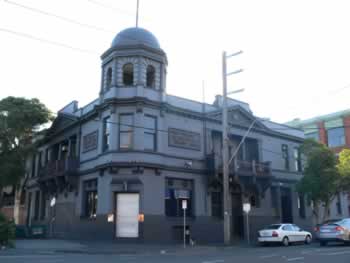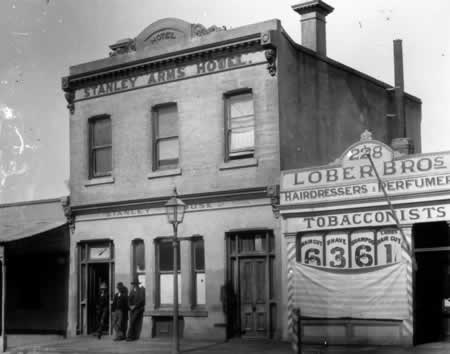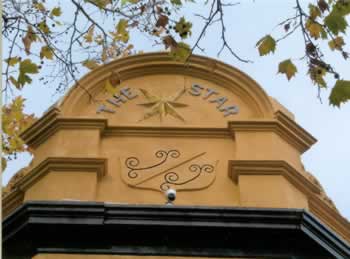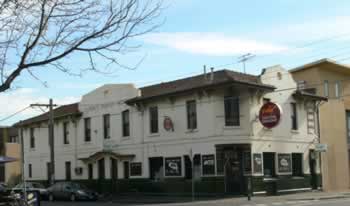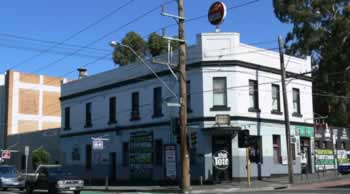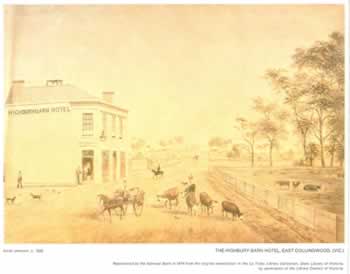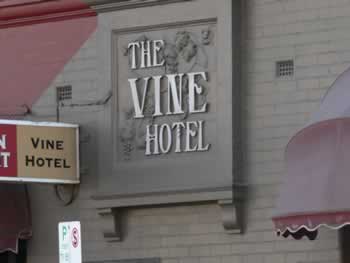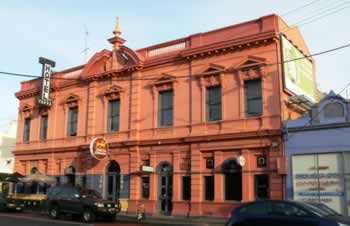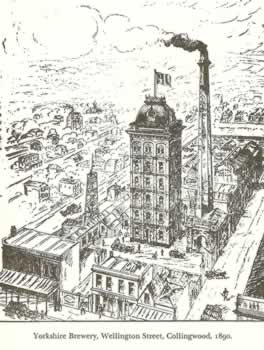Hotel:Abbotsford Hotel
Hotel Address:325 Johnston Street
Abbotsford, opposite Trenerry Crescent 3067
Australia
Map It
Abbotsford Hotel (by 1859 - 1923)
Abbotsford Abbey Hotel, (1854 - 185?)
1854
1923
Demolished
N/A
N/A
N/A
N/A
N/A
N/A
Kearney 1855: N; Hodgkinson 1858: Y? ; MMBW: Detail Plan 1284, 1901
A hotel called Abbotsford Abbey was licensed to Frederick Barnes in early 1854, and can be presumed to be the same one used as an inducement in an advertisement for land sales in 'the village of Abbotsford'.
'The road to this estate and the Abbotsford Gardens and Family Hotel has been made... thus making this property the more desirable [as there is] easy access even in the depth of winter... the extensive alterations and additions to the Abbotsford Hotel will make this one of the most favoured places of resort to the pleasure-loving community, and materially enhance the value of property in its immediate neighbourhood.'
(The Argus, 10 May 1854, p.10)
Nothing is heard of this hotel between 1855 and 1858, but from mid 1859 it features frequently in The Argus both in articles and its own advertisements, in which its location is again emphasised:
Abbotsford Hotel, Johnston-st, Collingwood, beautifully situated on the banks of the Yarra.- Picnic and tea parties accommodated. Respectable boarders wanted. Charges low.
(The Argus, 22 December, 1859, p. 8)
A building marked on Clement Hodgkinson's January 1858 map shows an unnamed building that seems to be in the correct spot for this hotel, so it is reasonable to surmise they are the same hotel, but possibly it ceased operations for a few years. In 1857 the Johnston Street bridge to Kew was built, providing more potential custom to hotels in Johnston street.
The 1864 ratebook lists the hotel as a stone building; in 1895 the hotel was for sale, described as the 'well-known Abbotsford Hotel', containing a bar, cellar, and eight rooms, stabling, out-offices, etc on land having 66 feet frontage to Johnston Street (near the tram terminus) by a depth of 99 feet. (The Argus, 11 December 1895, p. 2). The separate billiards room shown on the 1901 Board of Works map at the rear of the hotel may have been added by the new owner, but the new licensee did not serve her patrons as well as she should; Margaret Fowler was convicted of having falsely applied Hennessey and Dewar's labels to bottles of watered-down brandy and whisky ( The Argus, 29 October 1896, p. 3)
Hotel:Alliance Hotel
Hotel Address:Northwest corner Cambridge and Derby Street
Collingwood 3066
Australia
Map It
Alliance Hotel (1869 - 1871)
N/A
1869
1871
Demolished between 1872 and 1889. Corner shop now on site has date 1889 on pediment.
N/A
N/A
N/A
N/A
N/A
N/A
Kearney 1855: N; Hodgkinson 1858: N ; MMBW: N/A
In The Argus of 4 December 1869, the publican advertised that he wanted to purchase 'a good second-hand beer-engine'. (p. 7)
Hotel:Ayrshire Arms Hotel
Hotel Address:52A Palmer Street
Collingwood 3066
Australia
Map It
Ayrshire Arms Hotel (1871 - 1908)
N/A
1871
1908
residence
Corner doorway bricked up, later window added facing Perry Street
N/A
N/A
Part B, pp. 430-431
N/A
Contributory to HO324
Kearney 1855: N ; Hodgkinson 1858: N ; MMBW: Detail Plan 1197 & 1198, 1899.
There are a number of large and ornate hotels in Collingwood; this small mid-Victorian hotel is at the other end of the spectrum. Its restrained architectural details, size, and location in a minor street are indicative of a type of hotel serving a localised clientele, probably in humble circumstances. Most hotels of this type were de-licensed in the early twentieth century, and many were demolished. That this one remains is a lucky chance for us to gain some insight into a past lifestyle.
At the Licenses Reduction Board hearing in 1908
Arthur Darby, licensee, said he had a fair class of customers amongst the labouring classes. Very few of the 'belltopper gentlemen' came to his hotel. He denied that the hotel was damp. In reply to Inspector Dungey, witness said he had done some Sunday trading, but a few Sundays ago Constable Roxby visited the hotel and gave him a scare. Since then he had not done any but had taken a position as driver for a cordial manufacturer, so as to make up for the loss which he was sustaining through abstaining from Sunday trading.
The Argus, 28 February 1908. p. 9
Shortly after giving up its licence, the hotel was auctioned with the following description: 'Delicensed hotel... very substantial, brick, slated, one-storey building, 9 rooms; in good repair; now let at 2 pounds weekly... well-adapted for business and residence.' ( The Argus, 23 December 1908, p.2)
Hotel:Baden Powell Hotel
Hotel Address:61 Victoria Parade
Collingwood 3066
Australia
Map It
Baden Powell Hotel (1900 to present)
New Bendigo Hotel (1872 - 1899)
1872
N/A
Existing hotel
Renovated during the inter-war period in the Moderne style; windows later altered
N/A
N/A
Part C, pp. 633-634
N/A
Contributory to HO 336
Kearney 1855: N ; Hodgkinson 1858: N ; MMBW: Detail Plan 1197 & 1198, 1899.
Almost the first publican was Yorkshireman Joseph Brownhill, who was at the helm from 1873 until his death in 1891, when, in a common pattern for publicans, his wife Fanny took over. Brownhill had previously been licensee at the Norfolk Hotel in Easey Street.
The name of this hotel was changed in 1900 to commemorate Robert Baden-Powell. During the Second Boer War, Baden-Powell became a national hero for his role in the Siege of Mafeking, 1899-1900, the most famous British action in the Second Boer War.
The hotel was renovated again in 2008-2009; with the exception of enlarged ground floor windows, the exterior has not greatly changed.
Hotel:Bakers Arms Hotel
Hotel Address:355 Victoria Street,
Abbotsford 3067
Australia
Map It
Bakers Arms Hotel (1876 to present)
N/A
1876
N/A
Existing hotel
c.1935/1936
N/A
N/A
N/A
N/A
N/A
Kearney 1855: N ; Hodgkinson 1858: N ; MMBW: Detail Plan 1310, 1901
There was a bakery on the site before the hotel came into existence with Patrick Fenane as the first licensee.
In 1935 a reporter related an entertaining incident relating to an inhabitant of the hotel:
“Houses in Richmond from Church to Hoddle Street were without light for an hour... because a white cockatoo which had escaped from its cage at the Bakers Arms flew into a fusebox on an electric light pole... there was a violent explosion that could be heard a mile away... the bird's feathers were singed black ... Mr J O.Brien, licensee, retrieved the indignant bird and took it back to the hotel where it is responding to treatment.”
( The Argus February 1935, p. 8)
When the freehold was put up for auction in October 1936, the Bakers Arms was described as a brick building of two stories recently reconstructed on land 33 feet by 91 feet, with 16 rooms and all mod. cons. The highest bid was 9,700 pounds, at which figure the property was withdrawn from sale. ( The Argus, 27 October, p. 2 and 28 October, p.11)
This hotel is cluttered with signs; ground floor windows and doors have been altered or replaced; a single storey section has been added at the rear; but a closer look reveals the typical form of the old hotel with splayed corner and simple window treatments on the upper floor.
Hotel:Barnard's Hotel
Hotel Address:32 Peel Street
Collingwood 3066
Australia
Map It
Barnard's Hotel (1869 - 1914)
In 1871 Barnard applied to change the name to Barnard's Family Hotel, but there is no indication that this was put into effect.
1869
1914
Commercial premises
N/A
N/A
N/A
Part B, pp. 454-455
Volume 3, Appendix B, individually listed within precinct
Individually significant within HO318
Kearney 1855: N ; Hodgkinson 1858: N ; MMBW: Detail Plan 1201, 1899
William Barnard, a baker, owned a three-roomed timber shop on this site in 1868. The following year he built three brick shops, the corner one of which became the hotel. Barnard was the licensed victualler for many years, and also continued to conduct his business as a baker, pastrycook and confectioner until his death at the age of 74 in 1902. Barnard's probate documents include a detailed list of all the contents, ranging from the bakery cart and horse, to jars of jam, from bottles of liquor to numbers of glasses. The hotel and shops were bequeathed to his housekeeper Ann Dougherty, who shortly afterwards married James Condon. The couple continued the hotel and bakery businesses until the hotel was closed by the Licenses Reduction Board in 1914.
The hotel and adjacent shops form a pleasing example of bi-chrome brickwork. This is a building style for which the Collingwood Slope is noted, used in buildings ranging from the towering Yorkshire Brewery to small cottages.
Hotel:Bell Inn
Hotel Address:Perry Street, outhwest corner Palmer Street
Collingwood 3066
Australia
Map It
Bell Inn (1860 - 1871)
N/A
1860
1871
Demolished before 1899
N/A
N/A
N/A
N/A
N/A
N/A
Kearney 1855: N ; Hodgkinson 1858: N ; MMBW: N/A
Brick building with 11 rooms (Rate Book 1867). Not long after opening the Bell Inn was embroiled in a public controversy, played out in the East Collingwood courthouse and the pages of The Argus.
GUARDIANS OF THE PUBLIC MORALS
To the Editor of The Argus
Sir, _ As the police force are paid by the public for performing certain duties, I think it is but right that those duties should be performed in a manner quite different from the following.
On the evening of 2nd instant a sergeant and constable (both on duty) were drinking at the bar of the Bell Inn, Perry-street, East Collingwood, for upwards of two hours. The constable was afterwards carried home drunk by his wife, and had been previously seen rolling drunk in the public street with the landlord of the hotel.
AN OBSERVER
( The Argus, 9 July 1860, p. 5)
Landlord Samuel Colls responded angrily in print the following day, denying these allegations. The case against sergeant James Burns and constable Philip Meade was heard in court in what was described by The Argus as a 'peculiar and important case' and reported in great detail the following day. The charges were dismissed. ( The Argus 25 July 1860, p. 7).
Hotel:Bendigo Hotel
Hotel Address:125 Johnston Street
Collingwood 3066
Australia
Map It
Bendigo Hotel (1888 - present)
Collingwood Arms Hotel (1871-1887)
1871
N/A
Existing hotel
Demolished and rebuilt 1911
N/A
N/A
Part A, pp. 282-284
Volume 3, Appendix B, individually listed within precinct
Individually significant within HO 324
Kearney 1855: N ; Hodgkinson 1858: N ; MMBW: 1197 & 1198, 1899 (Note wrongly labelled Bedford Hotel)
Carlton Brewery bought the hotel in 1887. They demolished and replaced the old two-storey corner building in 1911, after purchasing additional land to increase the exposure to Johnston Street. The current hotel was built in an Art Nouveau influenced style, designed by Sydney Smith and Ogg.
An excellent photograph taken by Wolfgang Sievers in 1964 shows the distinctive 1911 style as it was meant to look. By the time John T Collins photographed the building in the early 1980s, paintwork had obscured the distinctive red brick and cement exterior but the overall design with two corner towers remains very striking.
The current hotel has a website at http://www.bendigohotel.com.au
Hotel:Beresford Arms Hotel
Hotel Address:Langridge Street, northeast corner Rokeby Street
Collingwood 3066
Australia
Map It
Beresford Arms Hotel (1868 - 1908)
N/A
18681908
N/A
n/A
N/A
N/A
N/A
N/A
N/A
N/A
Kearney 1855: N ; Hodgkinson 1858: N ; MMBW: Detail Plan 1201, 1899
The hotel opened in 1868 with a bar, two sitting rooms and three bedrooms. Local drinkers were well-served, as the Lord Nelson was already situated on the southeast corner of the intersection. It was closed by a ruling of the Licenses Reduction Board in 1908, when it was described as a very old, dilapidated, one-storey wooden structure, very poorly furnished. Constable Carlin stated that during the last seven years the hotel had been noted for trading in prohibited hours. Whenever he approached the place on Sundays, a number of men round about it scurried away, and it was common to see people coming through holes in the fence which enclosed a vacant piece of land adjoining the hotel. Another deposition described the Beresford Arms as 'the meeting place of undesirable characters, particularly after dark and on Sundays'. ( The Argus, 19 February 1908, p. 4)
It was hardly surprising, after such evidence, that the hotel was ordered to be closed.
Hotel:Brandon Hotel
Hotel Address:84 Smith Street
Collingwood 3066
Australia
Map It
Brandon Hotel (1897 - 1914)
City of Norwich Hotel (1865 - 1867), Gray's Hotel (1868 - 1872), London Hotel (1873 - 1880), Our Boys Hotel (1880), Flying Squadron Hotel (1881 - 1896)
1865
1914
Commercial premises
1870s?
N/A
N/A
N/A
N/A
Contributory to HO333
Kearney 1855: N/A ; Hodgkinson 1858: N/A ; MMBW: Detail Plan 1208, 1899
The 1867 rate book describes this as a six-roomed brick hotel, conducted by Mary Ann Tonkin. The existing building is certainly the same one that was there in the 1880s, but seems likely to have been re-built, perhaps in the early 1870s, as it is now one of a very similar group of shops which replaced shops which in 1867 were of timber construction.
The hotel changed publicans even more frequently than it changed its name. Luckily William Cuffley was there for long enough to have a photo taken for posterity. By 1883 Cuffley, who had operated a number of hotels around Melbourne and from 1878 until 1882 had been licensee at Steeth's Family Hotel in Wellington Street, was ensconced at the Flying Squadron where he stayed for four years. Family reminiscence has him as a kind and jovial sort of fellow - well suited to the role of publican. Alongside William and his wife in the photograph dating from the mid 1880s is his niece Emma Rosina Evans, whom he had taken in after she was widowed. The name of the hotel at this time refers to a British naval squadron.
Hotel:Brickmakers Arms
Hotel Address:367] Victoria Street, east of Flockhart Street (then called Brick Lane)
Abbotsford 3067
Australia
Map It
Brickmakers Arms Hotel (1853 - 1867)
N/A
1853
1867
Demolished
N/A
N/A
N/A
Part C, p. 655
Volume 2, Building Citations, Part II, pp. 381-382
N/A
Kearney 1855: Y ; Hodgkinson 1858: Y ; MMBW: N/A
The name refers to the early Collingwood brickmaking industry which was based around Flockhart Street. This was a brick hotel with eight rooms (Rate Book 1864 and 1865).
Hotel:Bristol and Bath Hotel
Hotel Address:66 Cromwell Street
Collingwood 3066
Australia
Map It
Bristol and Bath Hotel (1869 - 1908)
N/A
1869
1908
Boutique bordello
c. 1879
N/A
N/A
N/A
Volume 2, Building Citations, Part 1, pp. 101-102
HO 97 individually significant
Kearney 1855: N ; Hodgkinson: 1858: N ; MMBW map: Detail Plan 1210, 1899 (named Bath Hotel)
A stone hotel was on this site from at least 1869, but was re-built at some stage, possibly around 1879 (as evidenced by an increase in rateable value). In 1903 it was acquired by the Shamrock Brewery and in 1908 by Carlton & United Breweries. After de-licensing it became a residence.
The building is of local architectural significance, a free standing two storey symmetrical Italianate brick building with restrained decoration. It is particularly noteworthy nowadays that most surrounding nineteenth century housing has been demolished, leaving it standing in the midst of unprepossessing twentieth century industrial development as a testament to a lifestyle long gone.
Hotel:British Crown Hotel
Hotel Address:14 Smith Street, northeast corner Mason Street
Collingwood 3066
Australia
Map It
British Crown Hotel (2008 - present)
British Crown Hotel (1860 - 1983), Smith Street Bar & Bistro (1984 - 2008)
1859-1860
N/A
Existing hotel
Extended to include numbers 16 and 18.
N/A
N/A
N/A
N/A
Individually significant within HO333
Kearney 1855: N ; Hodgkinson 1858: N ; MMBW: Detail Plan 1208, 1899
James Cattach was the first publican from 1859 to 1867, and again from 1873 to 1877. In the twentieth century the Roberts family ran this hotel for 74 years. Catherine Roberts arrived from Sydney in the early 1900s, took over the upbringing of her recently orphaned four nieces and a nephew, and bought a pub. Her nephew Jack took over the licence in 1956, and he and his sister Katherine Hackett ran the place until August 1982, with irregular assistance from sisters Noreen, Joan and Pattie.
When my mother died auntie brought the five of us up. We lived above the hotel and boarded at Star of the Sea. The pub was a tiny little place then. We built on as the years went by. Aunty was a wonderful woman, one of those people everyone admired. She kept us kids out of the bar... we used to peep around the door to see what was going on. Everyone called her Aunt - it was known as Aunt's hotel and after her death as Jack's hotel. She was very regal. She'd tap on the counter and say "Come on now boys, you go home" I don't remember Collingwood being a tough place ... This block in Smith Street was really lovely then... It was a real community. Everyone knew each other.... Smith Street used to be so busy, you couldn't move here on a Friday night before the war, when there was late night shopping. It used to be good fun, we had a lovely crowd. They just went mad when Collingwood won the Premiership. We had to close at 6 pm, but people would dance in the streets.
(The Melbourne Times, 18 August 1982, pp. 1, 7)
After a period of time during which it was called the Smith Street Bar and Bistro, the hotel reverted to its original name in 2008.
Hotel:Builders Arms Hotel
Hotel Address:[325] Victoria Street (northeast corner of Nicholson Street)
Abbotsford 3067
Australia
Map It
Builders Arms Hotel (1878 - 1918)
Glasgow Arms (1868 - 1870), Sportsman's Arms (1871 - 1877)
1868
1918
Demolished
N/A
N/A
N/A
N/A
N/A
N/A
Kearney 1855: N ; Hodgkinson 1858: Building on site, unnamed ; MMBW: Detail Plan 1310, 1901 (no. 325, unnamed )
The first licensee was Ellen Collins; Richard Broughton, who had been the publican at several other hotels in Victoria Street, took over from 1878 until 1887; Mrs Ellen O'Shannessy was in charge from 1888 to 1894, while Mrs Morris managed only a brief stint from 1895 to 1896.
Hotel:Burke and Wills Hotel
Hotel Address:[311] Victoria Street (northeast corner of Little Charles Street)
Abbotsford 3067
Australia
Map It
Burke and Wills Hotel (1862 - 1918)
N/A
1862
1918
Demolished
N/A
N/A
N/A
N/A
N/A
N/A
Kearney 1855: N ; Hodgkinson 1858: N ; MMBW: Detail Plan 1311, 1901
This hotel was a brick building (Rate Book 1864) with three sitting rooms and four bedrooms.
The name commemorates the ill-fated expedition led in 1860-61 by Robert O'Hara Burke and William John Wills with the intention of crossing Australia from Melbourne in the south to the Gulf of Carpentaria in the north.
Like most hotels of the time, it was used for a variety of public meetings:
"A meeting of ratepayers of East Collingwood who feel aggrieved at the additional burden proposed to be imposed upon the burgesses by the borough council in the shape of an additional rate of 10d in 1 pound, assembled to the number of about 150 at the Burke and Wills Hotel, Simpson's-rd last evening for the purpose of getting up a protest against the additional taxation'."
( The Argus 12 September 1871)
Hotel:Caledonian Hotel
Hotel Address:Stanley Street, south side, corner Cambridge Street
Collingwood 3066
Australia
Map It
Caledonian Hotel (1868 - 1870)
Good Samaritan Hotel (1866 - 1867)
1866
1870
Demolished
N/A
N/A
N/A
N/A
N/A
N/A
Kearney 1855: N ; Hodgkinson 1858: N ; MMBW: Not verified
This hotel was listed as a wooden hotel with eight or nine rooms (Rate Book 1867, 1870). The publican was kept under the watchful eye of the local police:
SUNDAY TRADING AT CALEDONIA HOTEL, STANLEY ST
At the East Collingwood Police Court, William Sharp appeared for selling liquor on a Sunday at the Caledonia Hotel. The defendant was described from the witness box as the keeper of a shanty, but the police seemed to find it difficult to catch him tripping, in the way of Sunday trading, from the fact that it was the practice on Sundays to view the customers through a small hole, cut in the door and glazed, before giving them admission. Sergeant Fenton had seen a woman enter the house with a jug under her apron and come out again, where upon he entered.
Sergeant Fenton, on Sunday last, managed to get in without undergoing this preliminary survey, and found three men in the parlour drinking beer and two in the bar, the landlord behind the bar. For the defence, it was sworn by one of the three men that the whole of them were lodgers and that they did not pay for the beer, as it was given to them with their lunch. There was no evidence to show that the other two men were drinking, so the Bench dismissed the case, although, as they said, they had no doubt in their own minds that the drinks were sold and paid for.
( The Argus 8 October 1870 )
Hotel:Cambridge Arms Hotel
Hotel Address:[129] Cambridge Street, west side between Peel and Stanley Street
Collingwood 3066
Australia
Map It
Cambridge Arms Hotel (1853 - 1908)
N/A
1853
1908
Demolished early twentieth century; Foy and Gibson building constructed on site
N/A
N/A
N/A
N/A
N/A
N/A
Kearney 1855: N; Hodgkinson 1858: Y ; MMBW: Detail Plan 1201, 1899
By the time that the Licensing Reduction Board ruled that the hotel was to close, Carlton & United Breweries was the owner of the two-storey bluestone building. In July 1908 the Board took evidence as to the compensation payable to owners and licensees of delicensed hotels in Collingwood.
In the case of the Cambridge Arms Hotel, Cambridge Street expert evidence was called to show the value of the building with and without a licence.
'The building is old, of bluestone, but very substantial and it would cost 150 pounds to convert it to a dwelling. If a factory were built on it might return up to 7 per cent. For the licensee Mrs Margaret Thompson... it was contended that owing to her ill-health the takings had fallen very low, and did not represent the fair value of the license'.
( The Argus, 15 July 1908, p. 4)
Hotel:Carringbush Hotel
Hotel Address:226 Langridge Street,
Abbotsford 3067
Australia
Map It
Carringbush Hotel (1984 - present)
Langridge Family Hotel (1870 - 1889), Friendly Societies Hotel (1889 - 1984)
1869/1870
N/A
Existing hotel
1889
N/A
N/A
Part B, pp.309-310
N/A
Individually significant within HO 313
Kearney 1855: N ; Hodgkinson 1858: N ; MMBW: Detail Plan 1312, 1901
The Langridge Family Hotel first occupied this site, with John Grant as licensee for the whole of its life. The Friendly Societies Hotel was built in 1889, designed by architect James Wood, and originally incorporated a shop on the Langridge Street frontage (now the dining area). The owner and publican of the new building, William Nicholls, was a member of six friendly societies as well as being a Freemason and the hotel had a large room (40 feet by 18 feet) for lodge meetings.
“We paid a visit to the Friendly Societies Hotel... and found that brother Nicholls has done his best to provide accommodation for lodges. It is a splendid building from floor to roof. Electric bells and speaking tubes are fitted in the lodge-room, and raised platforms have been erected for the officers. We hope soon to hear that some of our lodges have moved to these commodious premises... a smoke night will be held this evening.”
( The Oddfellow, 2 December 1889, p.11)
The smoke night was reported on in the 6 January 1890 issue, and seemed to consist mainly of the singing of a great many songs, the name of each song, and the singer, being listed.
Nicholls spent the next ten years as the publican and was also an active member of the Licensed Victuallers' Association, serving as committee member or Vice-president. The hotel's current name 'Carringbush' is taken from Frank Hardy's novel Power without glory, in which the author used the term as a fictitious name for Collingwood.
Hotel:Carters Arms Hotel
Hotel Address:31 Gold Street
Collingwood 3066
Australia
Map It
Carters Arms Hotel (1872 - 1914)
N/A
1872
1914
Residential
N/A
N/A
N/A
N/A
N/A
Individually significant within HO 321
Kearney 1855: N ; Hodgkinson 1858: N ; MMBW: Detail Plan 1237, 1900
Mary O'Brien was the licensee in the 1890s and featured in the newspaper in relation to items ranging from a Sunday trading fine, to paying damages for injuries caused to a little girl who was bitten by her dog while playing in the street, to being the victim of theft of money from the bar.
In the twentieth century larrikins were making life difficult for local people:
The 'push' element is making its undesirable presence felt again in Collingwood. On Saturday evening at 11 pm, seven men entered the bar of the Carter's Arms... drinks for the party being called for. These were served but it soon became apparent that the men were on mischief bent. An attempt was made to rush the bar-parlour, but Mrs George Raiswell wife of the licensee promptly... locked the door. It was fortunate that she did so, for a moment later a soda bottle whizzed through the glass panel of another door and struck the door which Mrs Raiswell had just closed. A second crash was heard - this time windows in the billiard room being smashed. The cry of 'Police' was raised and the unwelcome visitors made off. Proceeding towards Johnston Street, some of the men tore pickets off the fences surrounding two houses and one was hurled through a plate glass window. The next scene of action was in the vicinity of the Engineers Arms in Johnston Street... Police arrived and took a hand in quelling the disturbance, which was witnessed by a crowd composed of several hundreds... Residents of Gold Street complain that their slumbers are disturbed, more especially on Saturday nights after the hotels are closed by 'pushes' the members of which sing ribald songs, make use of vile language and misconduct themselves generally.
( The Argus, 3 February 1914, p. 8)
Hotel:Claremont Hotel
Hotel Address:[35] Yarra Street
Abbotsford 3067
Australia
Map It
Claremont Hotel (1880 - 1923)
Lancashire Arms (1862 - 1880)
1862
1923
Demolished
Possibly cementing of front in early twentieth century
N/A
N/A
N/A
N/A
N/A
Kearney 1855: N; Hodgkinson 1858: N ; MMBW: Detail Plan 1283, 1901 (unnamed)
This photograph taken from the town hall tower in the mid 1880s does include the hotel in the distance, but is so indistinct that only the most determined researcher may find it worth examining.
Comments: This hotel may have existed even prior to 1862, because in that year tenders were invited for additions and alterations. ( The Argus, 26 August 1862, p. 3). Thomas Holland was a long-serving licensee from 1868. After Mr Dooley took over, he organised the 'Claremont Grand Seance' (a type of sweep) on the Champion Stakes. Applicants (maximum 500) paid five shillings, and were in the running for prizes of 45, 25, 18, 15, or 10 pounds.
The hotel was examined by the Licenses Reduction Board in 1908, but permitted to stay open. In 1921 it was for sale after the death of the owner, giving us some information about the building:
A well built, two storied brick and weatherboard building with HANDSOME MODERN CEMENTED FRONT, comprising bar, two parlours, sitting room, kitchen, four bedrooms and bathroom. Also cellar and necessary conveniences. Exceptional block of land 50 ft x 130 ft.
( The Argus, 30 July 1921, p. 2)
In January 1924 the building was advertised to let for 2 pounds weekly as a nine room delicensed hotel suitable for a boarding house or apartments.
Hotel:Clifton Hill Hotel
Hotel Address:89 Queens Parade,
Clifton Hill 3068
Australia
Map It
Clifton Hill Hotel (1884 to present)
N/A
1884
N/A
Existing hotel
Ground floor windows and tiled dado are more recent
N/A
N/A
Part B, pp.475-476
N/A
Individually significant within HO 330
Kearney 1855: N ; Hodgkinson 1858: N ; MMBW: Detail Plan 1217, 1901
Frederick Warming, whose name may still be seen inscribed on the pediment, originally owned this hotel , and had previously operated another hotel of the same name a few doors to the east . The two-storeyed Italianate stuccoed brick hotel, following the angle of the intersection with Wellington Street, is a prominent element in the largely Victorian Queen's Parade landscape.
Hotel:Clifton Hill Hotel
Hotel Address:Queen's Parade (possibly site of number 105)
Clifton Hill
Australia
Map It
Clifton Hill Hotel (1872 - 1884)
Daniel O'Connell Hotel (1869 - 1871)
1869
1883
Demolished
N/A
N/A
N/A
Part B, pp.475-476
N/A
Kearney 1855: N; Hodgkinson 1858: N; MMBW: N/A
The original name refers to the Irish political leader who campaigned for Catholic emancipation. The first publican was William Wainwright, followed by Eliza and Bridget Wainwright. The name Clifton Hill for the northern section of the municipality of Collingwood came into use in 1871, making the change of name very timely. This old hotel was leased for use as the Clifton Hill Police Station after the 1880s publican, Frederick Warming, built his own two-storey hotel a few doors to the west (see 20B).
Hotel:Clifton Hotel
Hotel Address:[32] Derby Street, Collingwood, near Oxford Street; later southeast corner of Langridge Street and Oxford Street, Collingwood
Collingwood 3066
Australia
Map It
Clifton Hotel (1853 - 1914)
N/A
1853
1914
Demolished by 1937
1883
N/A
N/A
N/A
N/A
N/A
Kearney 1855: Y ; Hodgkinson 1858: Y ; MMBW: Detail plan 1208, 1899
The original hotel was a stone building with ten rooms (Rate Book 1864, 1868) facing Derby Street, next door to the Clifton Assembly Rooms where a school was conducted from 1856 to 1877. It was many years later that Langridge Street was extended through from Wellington Street to Smith Street and created a direct link with Gertrude Street. The owner perhaps thought that this through road would be a more prominent site than Derby Street, and shortly after the road was completed Thomas Watts and Sons called for tenders for the erection of a two storey hotel on the corner of Langridge and Oxford streets ( The Argus 14 August 1883, p. 3). It is possible that the new hotel was built on the same plot of land, but facing the opposite direction.
It was closed by a decision of the Licenses Reduction Board. Around 1937 a building was constructed taking up the whole of the site from Derby Street to Langridge Street on the site formerly occupied by the hotel buildings.
Hotel:Commercial Hotel
Hotel Address:62 Smith Street, Collingwood
Collingwood 3066
Australia
Map It
Commercial Hotel (1869 - 1919)
N/A
Date on pediment 1866, first licence 1869
1919
Commercial premises
Bi-chrome brick exterior was probably later rendered after 1887. Corner door and adjoining windows altered in recent years.
N/A
N/A
N/A
N/A
Contributory to HO333
Kearney 1855: N ; Hodgkinson 1858: N ; MMBW: Detail plan 1208, 1899
Is seeing believing? Although the date on the pediment seems like a good piece of evidence, sources such as licensing records, rate books, and Sands and McDougall directories suggest it was not yet built in 1866. An 1880s photo of Langridge Street shows the side wall in brick. If the whole building was rendered after this time, the date may have been added then and relied on inaccurate data.
The first publican was Elijah Horwood who remained as publican from 1869 until 1884.
From 1930 until the 1970s the building housed the office of G.D. Langridge & Son, estate agents. In recent years the ground floor has been further altered to suit office/shop uses.
Hotel:Cornstalk Hotel
Hotel Address:[249] Victoria Street,
Abbotsford 3067
Australia
Map It
Cornstalk Hotel (1875 - 1900)
N/A
1875
1899/1900
Demolished c.1900 for railway line construction
N/A
N/A
N/A
N/A
N/A
N/A
Kearney 1855: N ; Hodgkinson 1858: N ; MMBW: No. 38, 1897 ; Detail Plan: N/A
Hotel:Council Club Hotel
Hotel Address:40 Johnston Street
Collingwood 3066
Australia
Map It
Council Club Hotel (1885 - 1936)
Council Hotel (1858 - 1884)
1858
1936
Substantially re-built in brick and extended after 1910, but at least one original wall remains - the bluestone west wall can be glimpsed in the tiny gap between two buildings.
N/A
N/A
N/A
N/A
Volume 3, p. 93, mention in description of HO315 Johnston Street Precinct
Contributory to HO 324
Kearney 1855: N ; Hodgkinson 1858: N ; MMBW: Detail plan 1238, 1900 (not named)
The name refers to the council chambers, which were located on the opposite side of Johnston Street prior to the building of the Collingwood Town Hall in the 1880s. The bluestone hotel was in the 1870s owned by Henry "Money" Miller, an investor who gave up politics in 1867 to concentrate on amassing city properties and pastoral holdings.
'On Wednesday evening last, the grand officers of the United Ancient Order of Druids assembled at Dredge's Council Hotel, Johnston-st, for the purpose of opening a new lodge. The President having initiated 43 members, the dispensation under which the lodge is held was read and the Lodge declared duly opened under the name of "The Prince Alfred". Brother Morffew D.P. of No 4 District was elected as arch-druid for the first term.'
( The Argus, 31/3/1871)
Hotel:Criterion Hotel
Hotel Address:115-117 [formerly 103] Johnston Street, Collingwood
Collingwood 3066
Australia
Map It
Criterion Hotel (1912 - 1914)
Galloway Arms (1854 - 1911)
18541914
Restaurant (115); charity office (117)
1888
N/A
N/A
N/A
Volume 3, p. 93, mention in description of HO315 Johnston Street Precinct
Individually significant within HO 324
Kearney 1855: N; Hodgkinson 1858: N ; MMBW: Detail Plan 1197 & 1198, 1899
The original hotel was a wooden structure, charmingly depicted by watercolourist Henry Gritten at the time when Abraham Howgate was the licensee after very brief stints by Robert McDuff and Frederick Poole. It was later rebuilt in two-storeyed Italianate style. James Page, a man active in local affairs and elected to council in the 1860s, was owner and licensee from at least 1861 until at least 1874. The owner until his death in 1910 was also called James Page, but may have been the son of the same name; both generations of the family lived at the hotel.
At the Licenses Reduction Board sittings in March 1908, James Page and licensee Mrs Rosetta McCully appeared. Page reported that the hotel had been rebuilt to meet the requirements of the Licensing inspector in 1888. Police reported that the house was well built and well conducted under the present licensee, though it had been not been so under previous licensees. Mrs McCully stated she had taken over in August 1907:
"There was a rough class of customers at the place then but she cleared them out, refurnished the place, and made a new start. The trade was steadily growing, and the customers were all of a very respectable class."
The Argus, 7 March 1908, p. 2
The hotel was allowed to continue trading continued trading but in April 1914 the Licenses Reduction Board handed down a decision that it was one of the hotels in excess in the Darling Ward.
The upper floor exterior of the building is substantially intact although the windows of 115 have been altered; the name and construction date can be seen on the pediment in raised letters. The ground floor has been completely altered for subsequent offices and shops on the premises.
Hotel:Crown and Anchor Hotel
Hotel Address:Langridge Street, northwest corner Rokeby Street
c 3066
Australia
Map It
Crown and Anchor Hotel (1883 - 1908)
Lord Nelson Hotel (1864? - 1873), Glasgow Arms Hotel (1873 - 1878), Yorkshire Arms Hotel (1878 - 1882)
1868
1908
Demolished
N/A
N/A
N/A
N/A
N/A
N/A
Kearney 1855: N ; Hodgkinson 1858: N ; MMBW: Detail Plan 1209, 1899
The early history of this hotel is shrouded in mystery and needs more research. We know that by 1864 it was housed in a brick building owned and conducted by Richard Peters, and that by 1868 it was called the Lord Nelson Hotel. It may have existed prior to 1864, and it may have had a different name in its first years of existence.
At a sitting of the Licenses Reduction Board in 1908, it was described as 'damp, dirty and dilapidated'. It contained nine rooms, was poorly furnished, and had no accommodation for lodgers. The owner explained that he had not spent any money on improvements because the hearing was imminent, but was of the opinion that given its central position, with improvements it would make a good hotel. ( The Argus, 21 February 1908, p. 3)
Hotel:Crown Hotel
Hotel Address:383-385 Victoria Street,
Abbotsford 3067
Australia
Map It
Crown Hotel (1912 - 1923)
East Collingwood Hotel (1872 - 1912)
1872
1923
Commercial premises
N/A
N/A
N/A
Part C, p. 651 and 660
Volume 2, Building Citations, Part II, pp. 375-376
HO59. Individually significant.
Kearney 1855: N ; Hodgkinson 1858: N ; MMBW: Detail plan 1310, 1901
The hotel was constructed for Irishman John Falvey, who owned a number of properties in neighbouring Lithgow Street. He may even have done some of the building, as he was a contractor. Ownership of the hotel remained in the family after his death in 1877, and for several years in the 1890s his widow Maria was the licensee; after her death in 1893 Miss Julia Falvey ran the hotel.
It is a good example of the Italianate style applied to a commercial building, with unusually detailed facades in intact condition.
Hotel:Duke of Albany Hotel
Hotel Address:323 Victoria Street,
Abbotsford 3067
Australia
Map It
Duke of Albany Hotel (1883 - c.1987)
Simpson's Hotel (1853-1883)
1853
c.1987
Cafe bar and restaurant
19th century, possibly around the time of the name change; remodelled in Moderne style in the inter-war years.
N/A
N/A
N/A
N/A
N/A
Kearney 1855: Y ; Hodgkinson 1858: Y ; MMBW: Detail Plan 1311, 1901
The earlier hotel, whose name recalls the original name of Victoria Street - Simpson's Road - was built of bluestone (Rate Book 1864). It has undergone many changes since then, being re-built in brick, remodelled in the 1930s, and remodelled yet again to suit the demands of the Vietnamese restaurant trade in the 1980s and then the cafe/bar trade of the 2000s. Like so many old commercial buildings, the ground floor exterior ends up bearing very little resemblance to the older building, while a view of the upper storey reveals its origins.
Hotel:Earl of Zetland Hotel
Hotel Address:Stanley Street, north side opposite Little Oxford Street
Collingwood 3066
Australia
Map It
Earl of Zetland Hotel (1855 - 1925)
N/A
1855
1925
Demolished
N/A
N/A
N/A
N/A
N/A
Kearney 1855: Y ; Hodgkinson 1858: Y ; MMBW: Detail Plan 1196, 1900
A substantial three-story corner stone building. The first publican was Samuel Turner, who was active in the Licensed Victuallers' Association. IN the 1870s it advertised 'furnished bedrooms 5s each with or without board'
Hotel:Exchange Hotel
Hotel Address:ambridge Street, northwest corner of Mason Street
Collingwood 3066
Australia
Map It
Exchange Hotel (1866 - 1871)
N/A
1866
1871
Demolished c.1873. The State school built on the site opened in September 1877.
N/A
N/A
N/A
N/A
N/A
N/A
Following the passing of the 1872 Education Act, the authorities investigated suitable buildings and sites in the area for the large new school which would be necessary to house the additional children attending compulsory school. Existing school buildings were deemed unsuitable, and towards the end of 1873 the Ministry of Education began the process of purchasing freehold properties in the block bounded by Cambridge Street and Mason Street, including this timber building with seven rooms (Rate Book 1867). Mr Upton, who was the last publican, may have wished he had been able to wait for the opportunity. In 1870 he was charged with Sunday trading; in 1871 he was declared insolvent, the cause being cited as 'dullness of trade'. ( The Argus, 25 January 1871, supplement p. 2).
Hotel:Exchange Hotel
Hotel Address:Perry Street, south side between Bedford & Wellington streets
Collingwood 3066
Australia
Map It
Exchange Hotel (1868 - 1875)
Sawyers Arms Hotel (1854 - 1867)
1854
1875
Demolished
N/A
N/A
N/A
N/A
N/A
N/A
Kearney 1855: N ; Hodgkinson 1858: Y ; MMBW: Detail Plan 1196, 1900 (possibly - not identified)
A wooden hotel with nine rooms (Rate Book 1867). The first publican was Edward Jones; in the 1860s Elijah Horwood was the licensee here before moving to the Commercial Hotel Smith Street in 1869.
In October 1871 there was an auction of furniture and fittings at the hotel; these included a bagatelle table with its cues, balls and fittings; parlour, dining room and bedroom furniture; bar utensils and fixtures, beer engine, and plated ware; kitchen requisites. All were to be sold without reserve, cash sales only. ( The Argus, 7 October 1871, p. 2).
In May of the following year the building itself was put up for sale by auctioneer G.D. Langridge, because the owner John Barnett was moving to Sydney. On land 50 feet by 100 feet, the 'most desirable property' was leased for five years at 52 pounds per annum and described as 'well worthy the attention of brewers, capitalists, etc, as a snug trade is always to be commanded, being immediately at the rear of the Court-house, Council chambers, &c'. ( The Argus, May 1872, p. 3)
Despite these advantages, the hotel ceased to function within a few years of the auction. Later uses of timber buildings in the vicinity included a night shelter for men, owned by Miss Singleton, and a laundry, but so far it has not been possible to establish whether either of these took over the old hotel.
Hotel:Fox Hotel
Hotel Address:351 Wellington Street, corner Alexandra Parade (formerly Reilly Street)
Collingwood 3066
Australia
Map It
Fox Hotel (2007 to present)
Fox's Hotel (1871-1882), Tower Hotel (1882 - c.1992), Office Inn (199?-2007)
1871
N/A
Existing hotel
Enlarged at some time after the 1890s photo was taken; renovated in the interwar period
N/A
N/A
N/A
N/A
Contributory to HO 321
Kearney 1855: N/A ; Hodgkinson 1858: N/A ; MMBW: Detail Plan 1214, 1900
In 1882 its name was changed to the Tower Hotel, a reference to the nearby Shot Tower, which was built in 1882. (See Shot tower)
The current owner has gone back to the hotel's origins for a choice of name.
Hotel:Gasometer Hotel
Hotel Address:484 Smith Street
Collingwood 3066
Australia
Map It
Gasometer Hotel (2010 to present)
Gasometer Hotel (1861 - c.1997), Irish Murphy's (c.1997 - 2000), Father Flanagan's Hotel (c.2001 - 2010)
1860/1861
N/A
Existing hotel
N/A
N/A
Part C, pp. 552-555
N/A
N/A
Kearney 1855: N ; Hodgkinson 1858: N ; MMBW: Detail Plan 1214, 1900
In 1859 architect Alfred Kursteiner invited tenders for the erection of a public house for Mr C. A. Mater. ( The Argus, 15 June 1859). The owner was Charles Mater, who owned a large tract of land bounded by Reilly Street (now Alexandra Parade) and Smith Street, and after whom Mater Street was named. The hotel's name is a reminder of the former Collingwood, Fitzroy and District Gas and Coke Company , which was established in 1859 and commenced supply from its works (diagonally opposite the hotel) in May 1861. However there was no denying that at the time of its erection, the hotel was in an area that was under-populated, and it was advertised with the following inducements:
To LET, on LEASE, erected as a pioneer to the settlement of a populous neighbourhood. The whole paddock adjoining is surveyed, with plans for sale in allotments at a low price with deferred payments. The new market contiguous is fenced. The great and increasing traffic of Smith-street, with the numerous employees at the gasworks, give assurance for the establishment of a good business within a short period.
( The Argus, 20 March 1860, p. 1)
The promised trade may not have eventuated, as there was a rapid turnover of publicans in the first few years. James Lawlor, James Crawley, and George Pashley followed one another in quick succession, while by August 1865 Mater and Co were again advertising it to let. By 1869 it was bought by Richard Benham who was also the licensee; it remained in Benham family ownership into the twentieth century.
The hotel is stuccoed stone and brick. The corner splay is emphasized with quoins and pilasters. After some years' flirtation with Irish-themed names, the hotel has recently returned to its original name.
Hotel:George Hotel
Hotel Address:31 Johnston Street
Collingwood 3066
Australia
Map It
George Hotel (1906 - 1914)
Court House Hotel (1865 - 1895), Federation (1899 - 1906)
1865
1914
Commercial premises and cafe
1939/1954
N/A
N/A
N/A
N/A
Contributory to HO 324; Appendix 7, pp. 321-323
Kearney 1855: N ; Hodgkinson 1858: N ; MMBW: Detail Plan 1196, 1900
he hotel was sited next door to the original East Collingwood Court House which gave the proprietor an obvious choice of name, and no doubt contributed to the custom. By the end of the century the court function had moved to the new Town Hall in Hoddle Street and the old court room was occupied by the Collingwood Working Men's Club, so the impending federation of states provided another choice of name.
The hotel was closed by the Licenses Reduction Board in 1914, along with seven other hotels in the Barkly and Darling Wards.
Most people walking past this building would assume the Victorian era pub was gone, because the frontage is composed of shops and office in a distinctive Moderne design (with later alterations). However a closer look reveals original chimneys and roof behind this facade, and peeking through the gate on the old carriageway on the west side gives the curious researcher gives a few more glimpses of the former hotel. The building became part of a larger complex of neighbouring buildings housing Gregory Steel Products until the1960s.
Hotel:Glasshouse Hotel
Hotel Address:51-55 Gipps Street
Collingwood 3066
Australia
Map It
Glasshouse Hotel (1853 to present)
N/A
1853
N/A
Existing hotel
1918
N/A
N/A
N/A
Volume 2, Building Citations, Part 1, pp. 135-136
HO103. Individually significant.
Kearney 1855: Y ; Hodgkinson 1858: Y (not named) ; MMBW: Detail Plan 1209, 1899
The original hotel on this site was built of brick, and its name refers to the nearby Glass House, one of Collingwood's earliest factories, in Glasshouse Lane, near the Rokeby Street corner. The surrounding electoral subdivision was named North Glasshouse.
In 1908, at the Licenses Reduction Board hearing, it was claimed that the present licensee was a teetotaller who was conducting the hotel better than it had been for 30 years past. The hotel was 'in the centre of a thickly populated locality' and there had been absolutely no Sunday trading since Robert Muirhead took charge, and business had increased.
The Chairman:- Increased trade after stoppage of Sunday trading! That ought to be made widely known. The moral effect would be considerable, I am sure. (Laughter)
( The Argus, 19 February 1908, p. 4)
The Glasshouse was permitted to continue trading. Carlton & United Breweries acquired the old hotel in 1910, and rebuilt in 1917-18.
The current building, despite some alterations, remains an eye-catching and unusual late Edwardian structure. The ground floor walls were originally face brick while the upper floor employed roughcast. There is a brown glazed tiled dado with decorative top and bottom courses. The roughcast has been painted over and some windows have been altered.
Hotel:Gloucester Hotel
Hotel Address:[291] Hoddle Street, on the northwest corner of Perry Street
Collingwood 3066
Australia
Map It
Gloucester Hotel (1858 - 1919)
Sometimes referred to as the Gloucester Arms
1858
1919
Demolished. Site is now part of the road
N/A
N/A
N/A
N/A
N/A
N/A
Kearney 1855: N/A ; Hodgkinson 1858: N/A ; MMBW: Detail Plan 1197 & 1198, 1899
A two-storeyed brick hotel.
At the Licenses Reduction Board hearing, licensee Mrs Jane Carpenter admitted that she frequently talked to friends through the open window on Sundays, but denied that any trading went on. Other witnesses gave evidence as to the good conduct of the hotel, and the 'public convenience it served, particularly in connection with sports gatherings on the Victoria-park.' ( The Argus, 7 March 1908, p. 22)
The background to this comment was that in 1903 Collingwood Council had abolished the sale of intoxicating liquor at the Victoria Park football and cricket ground. This led to the lengthening of the half-time interval to facilitate the exodus to the convivial atmosphere of local pubs, while those who stayed at the ground were kept amused by such entertainments as brass bands, boomerang throwing and foot races.
Hotel:Good Woman Hotel
Hotel Address:Sackville Street, southeast corner of Smith Street
Collingwood 3066
Australia
Map It
Good Woman Hotel (1866)
Old Gold-diggers Hotel (1865 - 1866)
1865
1866
Demolished by around 1915, when the building now number 358 Smith Street was built.
N/A
N/A
N/A
N/A
N/A
N/A
Kearney 1855: N ; Hodgkinson 1858: N ; MMBW: Detail Plan 1238, 1900 (?)
This building was a grocer's in 1864 before its brief life as a hotel, then a grocer's again, later becoming a greengrocer's for most of the remainder of the nineteenth century. The shop with a cellar, shown on the 1900 MMBW map as 358 Smith Street, may be the former hotel building.
Hotel:Grace Darling Hotel
Hotel Address:114 Smith Street
Collingwood 3066
Australia
Map It
Grace Darling Hotel (1854 to present)
N/A
1854
N/A
Existing hotel
1920s extensions on the Peel Street frontage.
VHR H0660
B3840
Part C, pp. 574-576
Volume 3, Appendix B, individually listed under precinct
HO135, VHR
Kearney 1855: Y ; Hodgkinson 1858: Y ; MMBW: Detail Plan 1208, 1899
As one of the few remaining 1850s hotels in Melbourne and one of the earliest surviving buildings in Collingwood, the Grace Darling is of both local and Melbourne-wide significance, providing a striking remnant of the early years of Melbourne's suburban development and an excellent example of an early stone building in Collingwood.
It is also famous as the site of the 1892 meeting associated with the eventual formation of the Collingwood Football Club.
Designed by George Wharton, the first owner and publican was Thomas Risby (from Tasmania). The Risby family owned the property until around 1870. Patrick Coyle, owner of the nearby Albion Hotel, was the publican from 1869 to 1879.
Built of bluestone, the hotel features Tasmanian sandstone door and window surrounds. Sydney Smith, Ogg and Serpell designed the surprisingly sympathetic 1920s extensions.
Its name commemorates the heroine of the wreck of the "Forfarshire" in 1838.
Hotel:Grosvenor Hotel
Hotel Address:[37] Grosvenor Street,
Abbotsford 3067
Australia
Map It
Grosvenor Hotel (1870 - 1918)
N/A
1870
1918
Demolished
N/A
N/A
N/A
N/A
N/A
N/A
Kearney 1855: N ; Hodgkinson 1858: N ; MMBW: Detail Plan 1305, 1901
The compensation paid for the deprivation of licence was 475 pounds. Not long after its de-licensing, the former Grosvenor was auctioned, described as a two-storied brick building, containing 12 rooms on land 40 feet by 99 feet, let at 25 shillings per week.
Hotel:Harp of Erin Hotel
Hotel Address:Park Street
Abbotsford 3067
Australia
Map It
Harp of Erin Hotel (1872 - 1908)
N/A
1872
1908
Residential
1970. Windows replaced.
N/A
N/A
N/A
Volume 2, Building citations, pp.305-306
HO 43, individually significant
Kearney 1855: N ; Hodgkinson 1858: N ; MMBW: Detail Plan 1311, 1901 (not named)
This is one of the rewards for researchers of Collingwood hotels: to wander down a back street and find that an insignificant hotel, de-licensed more than 100 years ago, is still in existence. The hotel was built by 1871 for Darby Reddan who remained as publican into the 1880s or 1890s. In 1893 the licence was transferred to Honora Reddan; other members of the Reddan family were publicans at several local hotels.
In 1907 the hotel was in the news in connection with a non-alcoholic beverage. Collingwood Council objected to a dairy being conducted in association with the hotel, not that it was a nuisance or unhygienic, but on the principle of the matter. After correspondence with the Board of Health the matter was dropped. ( The Argus, 30 July 1907, p.5)
Despite having been converted into two residences shortly after de-licensing and more recently modernised in appearance, the two old steps leading from the footpath, one of which would have led to the parlour and the other to the bar, stand as a reminder of a previous incarnation. While the majority of Collingwood hotels were built on major traffic and shopping routes, this is one of a handful built in a more out-of-the-way spot which would have served a local clientele. A second look at the building style give some insight into the original simple Italianate design and despite the modern windows, the original bracketed window sills remain on the first floor.
Hotel:John Barleycorn Hotel
Hotel Address:177-181 Johnston Street
Collingwood 3066
Australia
Map It
John Barleycorn Hotel (1974 - present)
City Hotel (1878 - 1973)
1876/78
N/A
Existing hotel
Alterations to exterior perhaps 1920s; ground floor exterior altered more recently
N/A
N/A
N/A
N/A
Contributory to HO 324
Kearney 1855: N/A ; Hodgkinson 1858: N/A ; MMBW: Detail Plan 1197 & 1198, 1899
Although the building has the date 1868 on the pediment, no evidence has yet been found to indicate that the hotel began operating before 1878, when Mrs Harriet Pryde was the publican. Mrs Pryde was unsuccessful in her first attempt to obtain a licence in December 1876, on the grounds of insufficient accommodation. She remained the publican until late in the nineteenth century, and the hotel was as frequently referred to as Pryde's Hotel or Pryde's Family Hotel as the City Hotel. It had a strong association with local sporting groups, being a popular venue for various cricket club meetings and for dinners provided by Mrs Pryde to the Abbotsford Football Club and the Collingwood Football Club.
The upstairs windows were re-modelled around the 1920s, and modern alterations to the ground floor windows have created a rather uninviting exterior.
Hotel:Jolly Hatters Hotel
Hotel Address:[46] Raphael Street,
Abbotsford 3067
Australia
Map It
Jolly Hatters Hotel (1894 - 1908)
Caulfield Arms (1868-1893)
1868
1908
Demolished by 1940
N/A
N/A
N/A
N/A
N/A
N/A
Kearney 1855: N ; Hodgkinson 1858: N ; MMBW: Detail Plan 1312, 1901
This bluestone hotel can be dimly seen in the distance in a photograph taken from the Town Hall tower. Its change of name in the early 1890s may be a reference to the Denton Hat Mills in nearby Nicholson Street, which expanded in size and importance in the 1880s.
It was delicensed in the first round of Licenses Reduction Board hearings; the owner was paid 500 pounds compensation and the occupier 120 pounds. The building appears to have been used as a residence until replaced by the current duplex pair of houses, numbers 44 and 46.
Hotel:Junction Hotel
Hotel Address:[229] Victoria Parade, northwest corner of Hoddle Street
Collingwood 3066
Australia
Map It
Junction Hotel (1870 - 1970)
N/A
1870
1970
Demolished 1971 for the widening of Hoddle Street
N/A
N/A
N/A
N/A
N/A
N/A
Kearney 1855: N; Hodgkinson 1858: N; MMBW: Detail Plan 1210, 1899
Hoddle Street was widened from Victoria Parade to Alexandra Parade in the early 1970s. All buildings on the west side of the road were demolished. We are lucky that the Collingwood and Fitzroy Courier photographer was out and about on the day that it was being wrecked.
Hotel:Kalgoorlie Hotel
Hotel Address:[130-132] now 168-172 Smith Street
Collingwood 3066
Australia
Map It
Kalgoorlie Hotel (1912 - 1918)
Clarke's Hotel (1853 - 1857), Mac's Hotel (1857 - 1912)
1853
1918
Demolished in February 2009
1919, 1930s, 1947
N/A
N/A
N/A
N/A
170-172 individually significant within HO 333; number 168 contributory to HO 333
Kearney 1855: Y ; Hodgkinson 1858: Y ; MMBW: 1201, 1899
James Clarke was the first licensee in a hotel on this site. Within a few years Thomas and Alexandrina McVea took over as owners and hotelkeepers, but Thomas soon died. Alexandrina re-married in 1861 and continued to run the hotel with her new husband Walter Murray, until she herself died in 1865. There followed a series of publicans, and several ownership changes, but the name Mac's Hotel was kept until well into the twentieth century.
The hotel can be seen in a photo taken around 1861. The section to the south is occupied by Caudle's drapery shop. Whether Caudle occupied just the ground floor, or that section of the building was completely divided from the northern section is arguable. The shop was rated separately (they had the same owner, but tenants were responsible for paying council rates in the nineteenth century), however the number of rooms mentioned in the rate books was low (e.g. in 1867 four in Caudle's, 28 in the hotel). This suggests that the hotel used the upper floors; certainly the name of the hotel is displayed right across the front of the building. By the time the MMBW plan was prepared in the late 19th century the buildings certainly seem to be separate.
After the closure of the Kalgoorlie Hotel, the property was tenanted by none other than members of the Coles family who moved into a larger shop than their previous (nothing over 1/-) shop further north in Smith Street. In 1921 G J Coles Pty Ltd was formed. The store was established within the old hotel fabric, which required extensive renovation; the lease was renewed in 1936 on the basis that improvements valued at 5,350 would be made. The property was extensively rebuilt in the Moderne style (attributed to Harry Norris, the regular Coles architect, although without specific evidence) and reduced to two stories. In 2004 a few remnants of the old hotel could still be found, as could elements of the 1919 renovation.
Number 172 (formerly Caudle's shop) was a butcher's shop for many years; all three storeys were retained and although the window openings were bricked up, it was easily identifiable by the distinctive parapet. Both buildings became more and more neglected in recent years, exacerbated by being included in a proposed Banco Group development in the mid 2000s. One fine Saturday in 2009 the buildings were quickly demolished...
This is a very complex site and the details are beyond the scope of this data sheet. Readers who would like to read more about may like to look at the following, as well as checking other items in this web page's bibliography:
Attachmen 6: Coles G J & Co Ld, Fancy Goods & Drapers ...
Hotel:Laird O'Cockpen Hotel
Hotel Address:149 Gipps Street
Collingwood 3066
Australia
Map It
Laird O'Cockpen Hotel (1869 to present)
N/A
1869
N/A
Existing hotel
1888/89; 1989/95 Conservation Study suggests possibly re-built around 1912
N/A
N/A
Part A, pp.155-156
Volume 3, Appendix B, individually listed within precinct
N/A
Maps: Kearney 1855: N ; Hodgkinson 1858: N ; MMBW: Detail Plan 1312, 1901
The name derives from a traditional Scottish song. The 1880s photos show a single storey corner building. In November 1888 architect Sydney Smith invited tenders for the pulling down and re-building of the Laird ( Building Engineers and Mining Journal 17 Nov 1888, supplement 7) .
The hotel was bought by the Burton Brewery, and then in 1912 Carlton & United Breweries acquired it.
The current building is brick, two storeys, with neo-classical detail and facade treatment. The brickwork has been overpainted, and ground floor windows and doors have been altered.
The Laird o' Cockpen
The laird o' Cockpen, he's proud an' he's great,
His mind is ta'en up wi' things o' the State;
He wanted a wife, his braw house to keep,
But favour wi' wooin' was fashious to seek.
Down by the dyke-side a lady did dwell,
At his table head he thought she'd look well,
McClish's ae daughter o' Claversha' Lee,
A penniless lass wi' a lang pedigree.
His wig was weel pouther'd and as gude as new,
His waistcoat was white, his coat it was blue;
He put on a ring, a sword, and cock'd hat,
And wha could refuse the laird wi' a' that?
(and many more verses to follow)
Hotel:Leinster Arms Hotel
Hotel Address:66 Gold Street
Collingwood 3066
Australia
Map It
Leinster Arms Hotel (1863/4 to present)
N/A
1863/64
N/A
Existing hotel
1930
N/A
N/A
N/A
Volume 3, Appendix B, individually listed under precinct
Individually significant within HO 321
Kearney 1855: N/A ; Hodgkinson 1858: N/A ; MMBW: Detail plan 1235, 1901
This hotel site reflects strong Irish connections in both name and publicans. Leinster is a province of Ireland and a source of a popular name for hotels both in Victoria and Ireland. The original bluestone building was owned and operated by various members of the McDonnell family until the death of John McDonnell in 1870, when another Irishman, Patrick Quinlivan, paid the executors 80 pounds for the goodwill and annual rental of 100 pounds. Quinlivan remained until 1882 and was followed by John Cahill, then Patrick Fitzpatrick and later Mary Cahir, who presided from 1926 until 1940.
The hotel was acquired by the Shamrock Brewing Company and eventually re-built in 1930. The hotel is very distinctive in appearance, with its clinker-brick and render Greek revival style standing in a street of mainly Victorian and Edwardian houses. The use of brick-on-edge detailing is unusual.
The Leinster Arms dining areas have been a popular upmarket venue for meals and drinks for some years, but there are still a number of 'old boys' propping up the bar who have been frequenting the hotel for many a long year.
Hotel:Limerick Castle Hotel
Hotel Address:Johnston Street (grounds of former Collingwood Technical School)
Collingwood 3066
Australia
Map It
Limerick Castle Hotel (1907 -1914)
Quarryman's Arms (1854 - 1870), Engineers Arms (1871 - 1906)
1854
1914
Demolished
c.1889
N/A
N/A
N/A
N/A
N/A
Kearney 1855: N ; Hodgkinson 1858: Y ; MMBW: Detail Plan 1196, 1900
The original Quarryman's Arms was a stone building; its first licensed victualler was Thomas Opie. At the time of its auction in May 1877 it comprised 11 rooms, bar, a lodge-room suitable for Oddfellows meetings, a ten stall stable and a cemented underground tank.
The hotel was rebuilt in 1889 and can be seen in a c.1912 photograph, which shows an ornate two-storey brick building with the construction date on the corner section of the pediment. Although not on a street corner, the architect has made good use of the narrow right of way to create a desirable splayed corner entrance. Publicans James and Margaret Tonini stand in the doorway. The hotel incorporated a tobacconist and barber's on the ground floor, and Tonini ran this business before moving into hotelkeeping around 1911. (There is an anomaly about the photograph, in that only the name Engineers' Arms can be seen, not the new name Limerick Castle).
Prior to Tonini's arrival, licensee Mrs Annie Featherby found herself the target of criticism at the Licensing Reduction Board sittings on 6 March 1908. The pub was suspected of Sunday trading, after-hours trading, and gambling (the latter also supposedly taking place at the tobacconist's), though nothing had been proved and no charges laid. While the hotel escaped closure at this time, it was closed down at a later round in 1914. John Wren's tote at what is now 148 Johnston Street, not far from this hotel, had been closed down in January 1907, so local punters would have been glad of another gambling outlet! (See Wren's tote )
The tobacconist and barber's business continued after the hotel ceased functioning. James (Jim) Tonini became a Collingwood councillor from 1918 to 1934 (Mayor in 1923-24) and from 1936 to 1947. The hotel building was eventually demolished to make way for the expansion of Collingwood Technical School.
Hotel:London Hotel
Hotel Address:[186, later 202A] Johnston Street,
Collingwood 3066
Australia
Map It
London Hotel (1883 - 1919)
Surrey Hotel (1862 - 1876), Shamrock Hotel (1876 - 1882)
1862
1919
Demolished c.1919.
N/A
N/A
N/A
N/A
N/A
Appendix 7, p. 327
Kearney 1855: N ; Hodgkinson 1858: N ; MMBW: Detail plan 1198, 1901
The carpet shop now at 200-202 Johnston Street is in the former Austral Theatre, which replaced this brick hotel and neighbouring shop. The Austral Theatre opened 15 September 1921.
Hotel:Londonderry Hotel
Hotel Address:Wellington Street, northeast corner of Vere Street
Collingwood 3066
Australia
Map It
Londonderry Hotel (1858 - 1925)
N/A
1858
1925
Demolished by 1969
N/A
N/A
N/A
N/A
N/A
N/A
Kearney 1855: N ; Hodgkinson 1858: N ; MMBW: Detail Plan 1197 & 1198, 1899
James and Martha Sawyers were associated with this hotel for many years as publican and owner. Shortly before its closure in 1925, licensee Terence Callaghan was running a dairy in Easey Street while his daughter Annie looked after the day-to-day running of the hotel. They became embroiled in a conspiracy case involving police detectives who placed stolen property at the hotel, then demanded money to cover it up. ( The Argus, 21 July 1925, p. 24)
Housing Commission of Victoria high rise flats were built on this site in the late 1960s.
Hotel:Magpie Hotel
Hotel Address:[65] Palmer Street, northwest corner of Perry Street
Collingwood 3066
Australia
Map It
Magpie Hotel (1895 - 1908)
Wattle Tree Hotel (1866-1894)
1866
1908
Demolished
N/A
N/A
N/A
N/A
N/A
N/A
Kearney 1855: N ; Hodgkinson 1858: N ; MMBW: Detail plan 1197 & 1198, 1899
Wooden structure (Rate Book 1867)
This hotel featured numerous times in reports in the local newspaper and The Argus. In 1883 the hotel was bombarded with stones and oyster shells by a group of men who had been put out of the hotel; Thomas Cross was prosecuted in 1885 for displaying inferior spirits in a bottle labelled John De Kuyper & Son; in 1901 William Goring traded out-of-hours and permitted drunks to remain. With the arrival of Mrs Maggie Murphy a little later in the 1900s the hotel's reputation for systematic Sunday trading improved somewhat, but at the Licenses Reduction hearing in February 1908 the building, although it incorporated eight rooms, was described as poorly furnished and with no accommodation for boarders.
Hotel:Massie's Hotel
Hotel Address:[121] Wellington Street
Collingwood 3066
Australia
Map It
Massie's Hotel (1870 - 1908)
N/A
1870
1908
Demolished early twentieth century
N/A
N/A
N/A
N/A
N/A
N/A
Kearney 1855: N ; Hodgkinson 1858: N ; MMBW: Detail Plan 1201, 1899
James Massie had been a blacksmith in Wellington Street before he turned to hotel-keeping. He first spent a year or two as licensee of the Star Hotel in nearby Peel Street before building his own hotel. He was the publican until the 1890s, and retained ownership of the building until its closure by the Licenses Reduction Board. At the hearing regarding the amount of compensation to be paid, Mr Johnson, a City of Collingwood valuer, and Mr Ashwood, architect and formerly house and land agent, gave evidence. Mr Johnson said that the valuation of the place was 80 pounds a year, and the rent was 2 pounds a week, which he considered fair. As a dwelling the house would be worth about 15/- or 16/- a week. Mr Ashworth thought that the hotel was worth 1,300 pounds and the vacant land 150 pounds. Delicensed, as a private house it would probably be worth 15/- per week and as a shop after extensive alterations say, 1 pound. Its capital value without a license would be about 575 pounds. ( The Argus, 17 July 1908 )
Return to the main hotels page
Hotel:Mechanics Arms Hotel
Hotel Address:Vere Street, north side, corner Emerald Street.
Collingwood 3066
Australia
Map It
Mechanics Arms Hotel (1869 - 1870)
Live & Let Live Hotel (1867 - 1868)
1867
1869
Demolished
N/A
N/A
N/A
N/A
N/A
N/A
Kearney 1855: N ; Hodgkinson 1858: N ; MMBW: 1199 & 1200, 1899(?)
The corner verandahed building shown as number 16 on the 1899 MMBW could be the old hotel building. The site of this hotel is part of the Housing Commission high rise flats built in the late 1960s.
Hotel:Norfolk Arms
Hotel Address:Lithgow Street, between the State School & Mollison Street
Abbotsford 3067
Australia
Map It
Norfolk Arms Hotel (1867 - 1883)
Sometimes referred to as the Norfolk Hotel
1867
1883
Demolished between 1883 and 1901
N/A
N/A
N/A
N/A
N/A
N/A
Kearney 1855: N ; Hodgkinson 1858: N ; MMBW: N/A
The hotel may not have been a very profitable business, as it was frequently advertised to let, for example in August 1869, December 1870, January 1875 and May 1875.
Hotel:Norfolk Hotel
Hotel Address:[54] Easey Street, northwest corner Budd Street
Collingwood 3066
Australia
Map It
Norfolk Hotel (1855 - 1908)
N/A
1855
1908
Demolished
N/A
N/A
N/A
N/A
N/A
N/A
Kearney 1855: N ; Hodgkinson 1858: Y ; MMBW: Detail Plan 1238, 1900 (unnamed corner building with cellar)
The application for a licence to Mr Breeze for his new hotel was granted on the condition that a ceiling be installed within two weeks. The hotel, presumably with its ceiling installed, was soon a popular place for a variety of meetings, ranging from the quarterly meetings of 'The Euphonics' to a meeting organised by John Jackson, a lobbyist for the erection of a bridge for Collingwood. At the latter 120 persons sat down to a complimentary dinner, 'furnished - with great credit - by Mr Breeze, the host'. Various councillors and members of Parliament attended, as did the Collingwood town clerk, while other worthies sent their apologies and accompanying cheques to assist Mr Jackson's cause. ( The Argus, 25 August 1856, p. 8 and 15 November 1856, p.5)
Mr John Edwards, one of the candidates for Collingwood, addressed two meetings of the electors last evening - one at the Abbotsford Hotel, Johnston street, and the other at the Norfolk Hotel. At both meetings motions in the candidate's favour were carried unanimously. At the Norfolk' a "free fight" took place, which lasted for some little time, but ultimately order was restored and maintained.
( The Argus, 25 July 1861, p. 4)
Newspapers reported extensively on a case in 1876 involving local youths feuding with the publican George Black. Two boys were charged with shooting to intent to wound. The event excited considerable interest as 'showing the extremities to which the disorderly youth of Collingwood would proceed' and being 'an act transcending in audacity anything yet done by the larrikin tribe of Collingwood'. However as the case unfolded, it seemed that Black had exaggerated and perhaps even manufactured evidence to incriminate the boys, and that, although a gun had been fired, it was loaded with only a few grains of powder and some paper to give him a fright, and caused no injury. ( The Argus, 3 April, p. 5 and 26 April, 1876, p. 5; The Mercury, 15 April 1876, p. 6)
Hotel:Normandy Hotel
Hotel Address:139 Queen's Parade,
Clifton Hill 3068
Australia
Map It
Normandy Hotel (1983 - 2009)
Dainton's Family Hotel (1875 - 1880), Normanby Hotel (1881 - 1982)
1875
c.2009
Currently for sale; development proposal for mixed residential and commercial use
N/A
N/A
N/A
Part B, pp. 481-482
N/A
Individually significant within HO 330
Kearney 1855: N ; Hodgkinson 1858: N ; MMBW: Detail Plan 1217, 1901
George Dainton, a stonemason, owned a house on this site before building the hotel. He was the first publican. After a few years he leased the hotel to another publican and the hotel name was changed, but Dainton retained ownership into the early 1890s. The hotel is a striking building, a large two storey Italianate hotel with corner splay and dentilated cornice line, decoratively enriched by quoining and pedimented window heads. A detached two storeyed block faces Gold Street. Exterior alterations have been minor compared to many other pubs.
In 1983 the owner was Arthur Amagnos and the manager Ted Cox. An article (or should that be advertorial) appeared in a local paper:
“…one of the new breed of sophisticated hotels appearing in Melbourne where patrons can relax in an atmospheric bistro, sip coffee or aperitifs in the piano bar, treat themselves to a sumptuous smorgasbord carvery at Sunday lunch or simply enjoy traditional hearty pub fare in the public bar.
(The Melbourne Times 15 December 1983)”
During the 1980s and 1990s it was a music venue with an Irish ambience and Guinness on tap, reaching a crescendo every St Patrick's Day when patrons spilled on to the footpath from the crowded interior.
Hotel:Oxford Arms Hotel
Hotel Address:[83] Oxford Street, west wide, north of Peel Street
Collingwood 3066
Australia
Map It
Oxford Arms Hotel (1858 - 1897)
N/A
1858
1897
Demolished c. 1898.
In October 1877 tenders were invited for plastering the Oxford Arms
N/A
N/A
Reference re building of Foy and Gibson factories
N/A
N/A
Kearney 1855: N ; Hodgkinson 1858: Y ; MMBW: N/A
Mrs Frances Kavanagh was the first publican and owner of this brick hotel, and remained until the late 1870s. In October 1877 the hotel was being spruced up, as tenders were invited first for plastering, then shortly afterwards for painting and wallpapering. ( The Argus, 17 October, and 29 October 1877, p. 3). This may have been in readiness for the sale of the hotel, or may have been done by the new owner.
As the Foy and Gibson retail and manufacturing empire expanded, the company bought up properties in Oxford and Cambridge streets to demolish and replace with their factories and warehouses. (See Foy and Gibson )
Hotel:Palmerston Hotel
Hotel Address:[45] Wellington Street, west side between Victoria Parade and Derby
Collingwood 3066
Australia
Map It
Palmerston Hotel (1866 - 1868)
Hancock's Family Hotel (1854 - 1866)
1854/1855
1868
Demolished
N/A
N/A
N/A
N/A
N/A
N/A
Kearney 1855: N ; Hodgkinson 1858: N ; MMBW: N/A
Described as brick in the 1864 rate book, and stone in the 1867 rate book, it was owned and operated by Albert Hancock in its first few years of existence. At the licenses hearing in 1855, a Mr Dyne opposed Hancock's application on the grounds that another hotel was not needed in the neighbourhood, there being others within a few yards. A Mr Stephen and a Mr Read supported the application: it was stated that the applicant, who had been a commander of a vessel, had laid out all his means in the erection of the hotel. ( The Argus, 7 March 1855, p. 5).
In November 1868 an auction was held at the Palmerston Hotel of surplus household furniture, a billiard table, and a six-pull beer-engine ( The Argus, 3 November 1868, p. 3). The Lady Franklin was only a few doors to the south, and in 1868 the Caledonian, later the Vine Hotel, opened up a few doors to the north - perhaps even in busy Wellington Street the competition was too fierce.
Hotel:Park Hotel
Hotel Address:191 Nicholson Street / 212 Vere Street,
Abbotsford 3067
Australia
Map It
Park Hotel (1864 to present)
N/A
1864
N/A
Existing hotel
Inter-war period renovation
N/A
N/A
N/A
N/A
Individually significant within HO 313
Kearney 1855: N/A ; Hodgkinson 1858: N/A ; MMBW: Detail Plan 1283, 1901
The current hotel retains basically the same corner form as is shown in the nineteenth century photograph, but has been greatly enlarged as well as undergoing a transformation into the Moderne style, fashionable in the 1930s. Some ground floor windows have been altered; the roof is now concealed behind a parapet.
Hotel:Phoenix Hotel
Hotel Address:267 Wellington Street
Collingwood 3066
Australia
Map It
Phoenix Hotel (1885 - 1919)
Woodthorpe Hotel (1875-1885)
1875
1919
Residential
N/A
N/A
N/A
N/A
N/A
N/A
Kearney 1855: N/A ; Hodgkinson 1858: N/A ; MMBW: Detail Plan 1237, 1900
This hotel opened in the same year as Steeth's Family Hotel, just after Wellington Street was extended from Johnston Street towards Clifton Hill. Nowadays the corner door opening has been filled in and the ground floor window frames altered, but otherwise Michael Torpey, publican from 1887 until 1892, could return to his hotel today and have no trouble recognising the exterior, although he might be a little surprised by the paint colours.
Hotel:Post Office Hotel
Hotel Address:[104] Smith Street, between the Grace Darling Hotel & Mac's Hotel
Collingwood 3066
Australia
Map It
Post Office Hotel (1866 - 1868)
N/A
1866
1868
Demolished
N/A
N/A
N/A
N/A
N/A
N/A
Kearney 1855: N ; Hodgkinson 1858: N ; MMBW: N/A
This short-lived wooden ten-roomed hotel was listed in the Sands & McDougall Directories and council ratebooks of 1867 and 1868. At the time most of the shops in this section of Smith Street were early wooden structures, soon to be replaced by brick and stucco. On 7 March 1868 auctioneer Alfred Cooper auctioned the furniture and stock of the hotel 'on account of the proprietor leaving the colony'. ( The Argus, 7 March 1868, page 2).
This hotel is not to be confused with a hotel of the same name on the Fitzroy side of Smith Street from 1871 onwar
Hotel:Prince of Wales Hotel
Hotel Address:[22] Otter Street, opposite Napoleon Street
Collingwood 3066
Australia
Map It
Prince of Wales Hotel (1853 - 1908)
N/A
1853
1908
Demolished
N/A
N/A
N/A
N/A
N/A
N/A
Kearney 1855: Y ; Hodgkinson 1858: Y ; MMBW: Detail Plan 1196, 1900
A brick hotel (Rate Book 1864), closed by the Licenses Reduction Board in 1908, its site is now part of the NMIT campus.
The image of the jolly publican was not always accurate as the following article shows; it is also a reminder that one of the sadder functions of hotels was as the venue for inquests:
Last Saturday morning a most determined suicide occurred in the Yarra near Johnston Street Bridge... With the assistance of a boat hook the body was brought on to the bank and then conveyed to the Early Bird hotel where it was identified as that of Stephen Hannaway, licensee of the Prince of Wales... [At the inquest] it was stated that the deceased had of late shown symptoms of unsoundness of mind and the verdict was that the deceased committed suicide whilst labouring under temporary insanity.
Mercury and Weekly Courier, 31 Aug 1878, p. 2
A later publican, Charles Pugh, who presided in the 1880s, was more successful, being complimented by the magistrate on the way he conducted his house, dealing with larrikins demanding free drinks, and hosting supper meetings for the Fitzroy Lodge of Instruction, a Masonic group of which he was a member.
Hotel:Prince Patrick Hotel
Hotel Address:135-141 Victoria Parade
Collingwood 3066
Australia
Map It
Prince Patrick Hotel (1882 to present)
Lancashire Arms (1865) , Serle's (1866 - 1867) , Galatea (1867 - 1872), Armstrong's Hotel (1873 - 1874), New Sydney (1875 - 1882). Note there is some inconsistency in naming in different sources around 1865 to 1867.
1865
N/A
Existing hotel
Rebuilt 1887
N/A
N/A
Part C, pp. 637-639
Volume 2, Building Citations, Part II, pp. 359-360
HO138. Individually significant
Kearney 1855: N/A ; Hodgkinson 1858: N/A ; MMBW: Detail Plan 1209, 1899
The Prince Patrick was re-built in 1887 in a highly ornamented Italianate style, incorporating two shops on the Victoria Parade frontage. The firm of Ravenscroft and Freeman may have been the architects. It remains substantially intact externally and is a prominent and decorative element in the Victoria Parade landscape.
Hotel:Punters Palace
Hotel Address:314 Smith Street
Collingwood 3066
Australia
Map It
Punters Palace (post 1995 - present)
Albion Hotel (1874/75 - 1989); Albion Inn (c.1990 - c.1995)
1874
N/A
Existing hotel
N/A
N/A
N/A
Part C, p. 569, p. 586
Volume 3, Appendix B, individually listed under precinct
Individually significant within HO333
Kearney 1855: N ; Hodgkinson 1858: N ; MMBW: Detail Plan 1196, 1900
On a corner site with a notable richly-decorated design including decorative use of grapes and vine leaves, the hotel was built for Patrick Coyle who had previously owned a house on the site. The first licensee was Patrick Devern.
Hotel:Railway Hotel
Hotel Address:Hoddle Street, southwest corner Easey Street
Collingwood 3066
Australia
Map It
Railway Hotel (1886 - 1971)
Butchers Arms Hotel (1871 - 1885)
1871
1971
Demolished c.1971 for the widening of Hoddle Street
N/A
N/A
N/A
N/A
N/A
N/A
Kearney 1855: N/A ; Hodgkinson 1858: N/A ; MMBW: Detail Plan 1236, 1901
The Butchers Arms was first licensed in 1871 to John Counter whose wife Sarah conducted the business because he was 'blind, deaf and dumb, and had been bedridden for eight years'. Counter had previously been at the nearby Highbury Barn. He survived his infirmities until 1878, when Sarah became the official licensee, transferring the licence to W. Clark in 1882.
A ghastly accident took place in 1933. Samuel Nelson, the barman, was killed by electricity in the cellar. He went to the cellar to connect a barrel of beer with the lead pipe leading from the cellar to the bar. When he did not re-appear, the licensee Mr O'Connor went to the cellar and found Nelson sitting on the floor, dead, his hands still grasping the pipe line. An electrician investigated and found that the pipe was crossed by a house wire carrying a current of 230 volts. ( The Argus, 18 September 1933, p. 4)
Hotel:Retreat Hotel
Hotel Address:226 Nicholson St,
Abbotsford 3067
Australia
Map It
Retreat Hotel (1873 to present)
N/A
1873
N/A
Existing hotel
Between 1915 and 1925
N/A
N/A
Part B, pp. 350-352
Volume 3, Appendix B, individually listed within precinct
Individually significant within HO 313
Kearney 1855: N ; Hodgkinson 1858: N ; MMBW: Detail plan 1284, 1901
The Retreat's charming and cosy interior made it an ideal choice as 'the local' for the filming of the Crawford Productions TV series The Sullivans, filmed in the late 1970s but set during World War Two. The two-storey exterior with a semi-circular corner turret presents a prominent and distinctive appearance on its corner site. The building shows Arts and Crafts influence.
Hotel:Rising Sun Hotel
Hotel Address:[100] Oxford Street, Collingwood, east side, between Peel and Stanley streets
Collingwood 3066
Australia
Map It
Rising Sun Hotel (1867 - 1870)
N/A
1867
1870
Demolished
N/A
N/A
N/A
N/A
N/A
N/A
Kearney 1855: N ; Hodgkinson 1858: N ; MMBW: Not identifiable
As the Foy and Gibson retail and manufacturing empire expanded, the company bought up properties in Oxford and Cambridge streets to demolish and replace with their factories and warehouses during the late nineteenth and early twentieth centuries. While we can safely say that the site of the Rising Sun was eventually incorporated into the Foy and Gibson factory complex, whether the building was demolished at that time or earlier has yet to be ascertained.
Hotel:Robert Burns Hotel
Hotel Address:376 Smith Street
Collingwood 3066
Australia
Map It
Robert Burns Hotel (1860 to present)
N/A
1860
N/A
Existing hotel
N/A
N/A
N/A
N/A
Individually significant within HO333
Kearney 1855: N ; Hodgkinson 1858: N ; MMBW: Detail Plan 1238, 1900
Although the brickwork has been damaged by unsuitable renovation methods, and the ground level exterior has been modified to some extent to suit modern usage, this hotel presents substantially the same face to the world as it has done for many long years, with its corner splay, simple pediment, and typical hotel window layout.
In 2011 the hotel was closed for some months while further alterations and renovations were undertaken by the new owners.
Hotel:Rose of Denmark Hotel
Hotel Address:Wellington Street,southeast corner Gipps Street
Collingwood 3066
Australia
Map It
Rose of Denmark Hotel (1865 - 1908)
N/A
1865
1908
Demolished
N/A
N/A
N/A
N/A
N/A
N/A
Kearney 1855: N ; Hodgkinson 1858: N ; MMBW: Detail Plan 1209, 1899
A two storey brick hotel which was involved with a Sunday trading charge within a year of opening. Publican Ellen Power was charged 5 pounds, a much higher fine than was usual. At the time of delicensing it was owned by Carlton & United Breweries.
A number of English pubs are called the Rose of Denmark, and the name is believed to refer to Alexandra, Princess of Wales, who was born in Denmark and in 1863 married the prince who became Edward VII in 1901.
Hotel:Royal George Hotel
Hotel Address:Hoddle Street, southwest corner Gipps Street
Collingwood 3066
Australia
Map It
Royal George Hotel (1854 - 1925)
N/A
1854
1925
Demolished by 1971 for the widening of Hoddle Street
N/A
n
N/A
N/A
N/A
N/A
Kearney 1855: Y ; Hodgkinson 1858: Y ; MMBW: Detail Plan 1210, 1899
The first publican, John Whiteoak, ran into financial difficulties by 1855, when an auction was held of all the furniture, stock-in-trade, and effects of the hotel, including, rather surprisingly, 50 loads of bluestone (pitchers, etc). He must have recovered from this setback as he was soon running the pub again.
In May 1857 the workmen connected with the erection of the Studley Park bridge dined together in celebration of the event at the Royal George. ( The Argus, May, 1937, '80 years ago').
The hotel was auctioned at the end of 1925, described as a well built two storey stone and brick building including a bar, billiard room, dining room, nine bedrooms, bathroom, lavatory, etc, on land 43 feet by 123 feet. ( The Argus, 16 December 1925, p. 2).
Hotel:Royal Hotel
Hotel Address:35 Spensley Street,
Clifton Hill 3068
Australia
Map It
Royal Hotel (1890 - present)
N/A
1889 /1890
N/A
Existing hotel
N/A
N/A
N/A
Part C, pp. 556-557
Volume 3, Appendix B, individually listed within precinct
Individually significant within HO 316
Kearney 1855: N ; Hodgkinson 1858: N ; MMBW: Detail Plan 1276, 1904
A decorative three-storey Italianate hotel built for John and Josephine Anderson. Tenders were invited in February 1889 and the acceptance announced in the Australasian Builder and Contractor's News 30 March, 1889. The architect was George Jobbins, and the original design as shown in the architectural drawings was to have included a corner tower, which would have made it an even more notable Clifton Hill landmark. Since the demolition of the Earl of Zetland and Mac's Hotel, this is the only remaining three-storey hotel in Collingwood.
The Andersons remained associated with the hotel for many years, while Mrs Anderson's siblings Ernest and Elizabeth Graham also served at the bar for decades. The Andersons quickly became active in the local community, especially Mr Anderson as a keen sportsman. He was elected president of the newly-formed Clifton Hill and Northcote Harriers, organised a committee in the hope of financing swimming baths on the Merri Creek, won the local pigeon shooting competition, and hosted smoke nights for the Clifton Hill and Northcote Cycling Club. Mrs Anderson died at the hotel in 1914, while Mr Anderson lived there until his death in 1938.
Hotel:Royal Hotel
Hotel Address:390 (formerly 392) Smith Street, southeast corner Keele Street (formerly Ryrie Street)
Collingwood 3066
Australia
Map It
Royal Hotel (1867 - 1919)
Vincent's Hotel (1861 - 1867)
Built and licensed in 1861
1919
Commercial premises
Early twentieth century
N/A
N/A
N/A
N/A
contributory to HO333
Kearney 1855: N ; Hodgkinson 1858: N ; MMBW: Detail Plan 1238, 1900. Not named.
Mr Vincent lived on this site before the hotel was built, being a blacksmith and then a grocer before building a hotel. Without further expert investigation it is hard to say whether his old pub was demolished and the current building, with its typically twentieth century architectural elements, was built from scratch, or whether the original building was substantially altered. The building footprint, corner doorway, brick rear side wall and foundations look as though they could belong to the earlier building. The City of Yarra heritage database describes the current building, now number 390 but originally 390 and 392, as dating from the 1900 to 1915 period. If this is correct, the building was rebuilt or remodelled during its life as a hotel, however since the neighbouring building was incorporated into the same building after it ceased trading as a hotel, the evidence seems a little contradictory.
Hotel:Royal Oak Hotel
Hotel Address:391 Victoria Street, northwest corner Albert Street
Abbotsford 3067
Australia
Map It
Royal Oak Hotel (1874 - c.1986)
Woolpack Hotel (1865 - 1873)
1865
c.1986
Restaurant
c. 1897
N/A
N/A
N/A
N/A
N/A
Kearney 1855: N ; Hodgkinson 1858: N ; MMBW: Detail Plan 1310, 1901
Architectural firm Hyndman and Bates invited tenders for the erection of the Royal Oak Hotel for Samuel Gillott Esq in the Building Engineering and Mining Journal 26 June 1897, supplement, p. 2; a builder's tender was accepted in the same journal 10 July 1897, p. 3.
Today, ground floor windows and doors have been altered and the brickwork has been painted, but the upper storey reveals the simple decorative treatment of their building, which replaced the earlier hotel.
Hotel:Shakespeare Hotel
Hotel Address:[240 or 314] Wellington Street, between Perry and Johnston Street
Collingwood 3066
Australia
Map It
Shakespeare Hotel (1869 - 1870)
N/A
1869
1870
Presumed demolished
N/A
N/A
N/A
N/A
N/A
N/A
Kearney 1855: N ; Hodgkinson 1858: N ; MMBW: Not verified
Most of the buildings in this block were built later than 1870, but so far it has not been possible to identify exactly where the hotel was and which building replaced it.
Hotel:Sir Henry Loch Hotel
Hotel Address:Johnston St, southwest corner Hoddle Street
Collingwood 3066
Australia
Map It
Sir Henry Loch Hotel (1885 - 1971)
Weighbridge Hotel (1865 - 1884)
1865
1971
Demolished c.1971 for the widening of Hoddle Street
Rebuilt, date not known
N/A
N/A
N/A
N/A
N/A
Kearney 1855: N ; Hodgkinson 1858: N ; MMBW: Detail Plan 1197 & 1198, 1899
The original name of this hotel refers to the weighbridge that used to be on the other side of Johnston Street. Thomas Ransom was the first licensee, moving here from the Highbury Barn hotel at the other end of Hoddle Street. John Cooper was the licensee in the 1880s; Mrs John Cooper was granted permission to carry on the business for two months during her husband's absence in April 1881. The name change was a response to the appointment of Sir Henry Loch as Governor of Victoria in 1884.
The first hotel was built of wood, and replaced at an as yet unknown date.
Hotel:Sir John Franklin Hotel
Hotel Address:75a-77 Victoria Parade
Collingwood 3066
Australia
Map It
Sir John Franklin Hotel (1853 - 1925)
N/A
1853
1925
Restaurants
1880-90
N/A
N/A
Part C, pp. 635-636
Volume 3, Appendix B, individually listed within precinct
Individually significant within HO336
Kearney 1855: N ; Hodgkinson 1858: Y ; MMBW: Detail Plan 1208, 1899
The old stone hotel was replaced in the later nineteenth century by a richly ornamented Italianate style two-storey building which incorporated a shop. The building remains substantially intact as a distinctive nineteenth century facet of the character of Victoria Parade, although the stucco has been painted and some minor alterations made.
John and Elizabeth Davison were associated with the hotel from 1853. Mrs Davison took over as licensee in 1862 after her husband's death and remained in charge until 1899.
Sir John Franklin was a well-known explorer who was also Governor of Tasmania from 1836 to 1843.
Hotel:Sir Robert Peel Hotel
Hotel Address:125 Wellington Street
Collingwood 3066
Australia
Map It
Sir Robert Peel Hotel (1858 to present)
N/A
1857/58
N/A
Existing hotel
1911-12, 1926, and 1967
N/A
N/A
Part C, pp. 688, 693
Volume 2, Building Citations, Part II, pp. 407-408
HO 142, individually significant
Kearney 1855: N ; Hodgkinson 1858: Y ; MMBW: Detail Plan 1208, 1899
The original brick hotel was built in 1857. In 1858 the first licensee was John Thomas Wood, proprietor of the Yorkshire Brewery on the opposite side of Wellington Street. It must have been a substantial building, because its gross annual value as listed in the 1864 Collingwood municipal rate book was 250 pounds, equal to the Grace Darling and Mac's Hotel in Smith Street. Carlton Brewery bought the hotel in 1887; around 1911 it was demolished and replaced by the existing building, designed by Sydney Smith & Ogg. Some alterations were made in 1926, while extensive renovations took place in 1967, at which time the facade was painted. Some of the Peel Street windows have been filled in. It remains a good example of the Edwardian free classical revival style, but the details are unfortunately obscured by the external paintwork.
The name (and that of Peel Street) refers to the British statesman (Home Secretary 1822-1827, Prime Minister 1834-5 and 1841-46) who helped create the modern concept of the police force, giving rise to the terms 'bobbies' in England and 'peelers' in Ireland. He has given his name to at least a dozen pubs in the United Kingdom.
Hotel:Somerset Hotel
Hotel Address:96 Perry Street, northwest corner Campbell Street
Collingwood 3066
Australia
Map It
Somerset Hotel (1871 - 1925)
N/A
1871
1925
Demolished
N/A
N/A
N/A
N/A
N/A
N/A
Kearney 1855: N ; Hodgkinson 1858: N ; MMBW: Detail Plan 1197 & 1198, 1899
For a small street, Perry Street was well-served with pubs. The Wattle Tree was already operating in 1871 when the Somerset and the Ayrshire Arms opened within a short block of each other, while the Bell Inn closed in the same year.
Hotel:Stag's Head Hotel
Hotel Address:Rokeby Street
Collingwood 3066
Australia
Map It
Stag's Head Hotel (1854 - c1855)
N/A
1854
1855?
Presumed demolished
N/A
N/A
N/A
N/A
N/A
N/A
Kearney 1855: N ; Hodgkinson 1858: N ; MMBW: Not verifiable
Frederick Grundman was granted a licence for this hotel in 1854, but whether it ever operated or precisely where in Rokeby Street it was, is not known.
Hotel:Stanley Arms Hotel
Hotel Address:[230] Wellington Street, east side, opposite Stanley Street, between Vere and Singleton (formerly Little Smith) streets
Collingwood 3066
Australia
Map It
Stanley Arms Hotel (1867 - 1885)
N/A
1867
1885
Demolished
N/A
N/A
N/A
N/A
N/A
N/A
Kearney 1855: N ; Hodgkinson 1858: N ; MMBW: Detail Plan 1199 & 1200, 1899 ( building in between numbers 228 and 230)
At the Licensing meeting in January 1885 there was strong opposition to the renewal of a licence to the Stanley Arms Hotel. Petitions for and against the continuance of the hotel were read from the residents in the immediate vicinity, and a long time was spent in arguments, many witnesses giving evidence against or in favour of the hotel. The application for a licence to the current landlady, Mrs Hollingsworth, was refused, and application was then made for a licence to a Miss Maher. This, too, was opposed on the grounds that the hotel was not required, and the application was adjourned for a month. ( The Argus 21 January 1885, p. 9). A further application was made in December, but was again refused.
A photo taken in the early 1890s shows a simply-decorated symmetrical two storey building looking much as it would have done when it was operating, even to a few loungers standing about outside. The word hotel has been painted over with 'house'.
Hotel:Star Hotel
Hotel Address:9-11 Peel Street, southeast corner Little Oxford Street
Collingwood 3066
Australia
Map It
Star Hotel (1868 - 1925)
N/A
1868
1925
Had been for sale and/or unused since the demise of the Trade Bar, but is undergoing renovation in 2011 and will soon open as a bar.
N/A
N/A
N/A
Part B, pp. 449-450
N/A
Individually significant within HO 318
Kearney 1855: N ; Hodgkinson 1858: N ; MMBW: Detail Plan 1208, 1899
Built by Thomas Veal who had previously owned a house on the site with a timber shop adjoining, the first licensee was James Massie, who soon left to run his own hotel (Massie's) in Wellington Street. There were frequent changes of licensees, with the longest stretch being that of owner Mrs Mary Maher, who after the death of her husband Thomas in 1878 took on the day-to-day business. In 1887 architect Harry B Gibbs supervised the replacement of the shop with the present brick structure, as well as alterations to the hotel. Mrs Maher handed over the reins to another publican in 1889, but continued as owner well into the twentieth century.
Around 1890 the Star became the home of the Loyal Lincoln Lodge of the I.O.O.F. At a meeting held in 1891, after business was completed 'members and visitors indulged in a little relaxation in the form of harmony... in which many gave their services to make the rest merry [by] the musical portion of the evening.' ( The Argus, 5 February 1891, p. 3)
After delicensing, the hotel was used for residential purposes. In the 1930s it accommodated unemployed men, and indeed was mentioned in a slum investigation report as the overcrowded residence of 56 such men. After being divided into apartments in the late 1960s, the building was rescued from oblivion when it housed Iain Hewitson and Sigmund Jorgensen's Clichy Restaurant from 1977. Later, Jock's Bar flourished briefly, followed around 2002 by the Gay Trade Bar, which closed about 2007.
The Star is a very attractive corner building, which incorporates various architectural references to its name in the exterior decoration. The window frames have unusual detailing, and the shop window is substantially intact, although the verandah has been removed. The buildings contribute to Peel Street which retains, among ugly modern factories, a number of Victorian buildings with unusually intact exteriors.
Hotel:Stirling Castle Hotel -
Hotel Address:Smith Street, somewhere in between 98 and 108
Collingwood 3066
Australia
Map It
Stirling Castle Hotel (1853 - c.1870)
N/A
1853
1869/70
Demolished 1870s?
N/A
N/A
N/A
N/A
N/A
Current buildings on site contributory to HO333
Kearney 1855: Y ; Hodgkinson 1858: Y ; MMBW: N/A
This was described as a stone building in the 1864 rate book, and as plaster in the 1867 rate book, probably meaning the bluestone had been rendered. During its lifetime, this hotel had 12 publicans, most only staying for a year. In its final year of operation, the publican was J Blake, who the following year was a wine merchant, possibly in the same building. In the late 1860s there were still a number of the older timber buildings in Smith Street, but with growing prosperity and the increasing commercial importance of the street, which was overtaking Wellington Street in popularity, owners were replacing these with more substantial brick. In 1869 Charles Brown owned the hotel and one wooden shop; by 1874 he owned four shops, which were probably the group of four two-storey shops currently numbered 100 to 106. The site of the hotel was therefore probably somewhere on the land now covered by these shops.
Hotel:Studley Arms Hotel
Hotel Address:[274, later 252] Wellington Street, northeast corner Little Bedford Street
Collingwood 3066
Australia
Map It
Studley Arms Hotel (1850 - 1908)
N/A
1850/51
1908
Demolished c.1968
Enlarged in 1852 to accommodate the influx of gold immigrants
N/A
N/A
N/A
N/A
N/A
Kearney 1855: Y ; Hodgkinson 1858: Y ; MMBW: Detail Plan 1197 & 1198, 1899
Peter Petherick, Collingwood rate collector and sometime councillor, owned and occupied the two-storey bluestone hotel from about 1861 until his death in 1877. According to his son Edward, the Studley originally belonged to Alderman John Hodgson and was the most substantial hotel in the district; it was originally planned as three shops, one of which was afterwards used for municipal offices and the Court of Petty Sessions until purpose-built structures were erected in Johnston Street in 1859.
In 1862 an anonymous letter in the Collingwood Observer remarked of Councillor Petherick: 'Being chairman of the public works committee what more natural than that contractors and their men should flock to the bar of the Studley Arms where the landlord can dispense nobblers and patronage at the same time'.
In 1863 the first large public meeting of the Labour, Protection and Tariff Reform League was held at the Studley Arms. Collingwood was at the forefront of the Victorian protectionist movement, supported by Graham Berry's Observer. Petherick's daughter Rosa conducted a private school in the hotel in the 1870s (perhaps in the room formerly used for council meetings).
By 1900 the hotel was owned by the Castlemaine Brewing Company. After closure, the building became a laundry, then Cockatoo Preserves Pty Ltd and eventually spent many years as a cardboard box factory, first operated by the Austral Box Manufacturing Company, and later Wood and Carson Pty Ltd. By January 1964 its bluestone walls were still looking very solid, but with its lower storey windows altered and doors replaced it had an uninviting air, hard to imagine as the centre of conviviality and political intrigue that it once was. All the buildings in the block of Wellington Street bounded by Vere and Perry Streets were demolished 1968/1969 for the building of Housing Commission high rise flats.
Hotel:Studley's
Hotel Address:[375] later 413 Johnston Street, southeast corner Clarke Street
Abbotsford 3067
Australia
Map It
Studley's (1987 - 1990s)
Early Bird Hotel (1865 - 1922), Studley Park Hotel (by 1923 - 1986)
1865
N/A
VIT Cafe, where hospitality students undertake practical training in the kitchen.
1925
N/A
n
N/A
N/A
N/A
Kearney 1855: N ; Hodgkinson 1858: N/A ; MMBW: Detail Plan 1285, 1901
A small single storey hotel strategically placed near the Studley Park Bridge, the original hotel was associated with the Crown Brewery once located just behind it. The earlier photo shows a slightly disreputable looking pub; by 1918 it had a wide verandah extending over the footpath. The two storey hotel built in 1925 was brick with a horizontal rendered band and cornice separating the upper and lower floors, a tiled dado and stained glass windows. A corner pediment had the date 1925 at the top, and panels of concrete render on both street frontages had the name "Studley Park Hotel" in raised letters. The parapet concealed the roof. On the upper level of the Johnston Street frontage there was a loggia with brick piers, a small balcony extending over the footpath. At first glance the existing building is almost unrecognisable, after extensive alterations in the late twentieth century. The most noticeable change is the extensive use of glass at both levels in the corner section. In addition the pediment has been substantially changed, all the windows have been altered, the doors have been re-positioned and the dado is painted. These changes probably happened at the time its name was changed to Studley's. A lunch review in 1989 described it as having undergone a lot of recent refurbishment, spacious, plenty of daylight, all soft pinks and greys .. unfortunately the reviewer's view of the food, wine list, and service did not match the decor. ( The Melbourne Times, 23 August 1989, p. 19). Studley's, which was owned by Collingwood footballer Peter Daicos, also provided evening entertainment, with bands several nights a week.
After the demise of Studley's, the old hotel became the site for Watson and Di Palma, a short-lived partnership in the mid- 2000s between Jimmy Watson's Wine Bar and Di Palma restaurateurs. It is now conducted by the Victoria Institute of Technology.
Hotel:Suffolk Hotel
Hotel Address:Stanley Street, north side between Wellington and Smith streets, opposite the west footpath of Cambridge Street
Collingwood 3066
Australia
Map It
Suffolk Hotel (1865 - 1908)
N/A
1865
1908
Demolished
N/A
N/A
N/A
N/A
N/A
N/A
Kearney 1855: N ; Hodgkinson 1858: N ; MMBW: Detail Plan 1196, 1900
The Suffolk was a stone hotel with seven or eight rooms (Rate Book 1867 and 1870).
Hotel:Terminus Hotel
Hotel Address:605 Victoria Street
Abbotsford 3067
Australia
Map It
Terminus Hotel (1923 to present)
Brickmakers Arms (1867 - 1923)
Built 1866 or 1867; licensed 1867
N/A
Existing hotel
1930s
N/A
N/A
Part C, pp. 654-657
Volume 2, Building Citations, Part II, pp. 381-382
HO62. Individually significant
Kearney 1855: N ; Hodgkinson 1858: N ; MMBW: Detail Plan 1305, 1901 (no. 593)
By 1867 Robert Dehnert, a prominent local brickmaker and landowner, had erected the present Brickmakers Arms on the Flockhart Street corner, retaining the name of the earlier hotel a few doors to the east, which derived from the Collingwood brickmaking industry based around Flockhart Street. Members of the Dehnert family were associated with the hotel into the twentieth century, and many of the other licensees also had names of German origin. In 1923 the name was changed to the Terminus, reflecting the location of the hotel near the end of the Victoria street cable tram route which terminated at Victoria Bridge. The building was later remodelled in the Moderne style. It displays typical features of the style such as steel-framed windows, curved corner, and horizontal facade treatment, the ground floor dado being tiled with distinctive bands of cream, green, and black tiles.
The Terminus was used as the location for the watering hole of undercover cop Peter Church in the TV program Stingers.
Hotel:The Gem
Hotel Address:285 Wellington Street
Collingwood 3066
Australia
Map It
The Gem (c.2006 - present)
Steeth's Family Hotel (1875-1883), Curry's Family Hotel (1884 - c.2006)
1875
N/A
Existing hotel
1927l
N/A
N/A
N/A
N/A
Individually significant within HO 321; Appendix 7, p. 500-501
Kearney 1855: N ; Hodgkinson 1858: N ; MMBW: Detail Plan 1237, 1900
While Wellington Street was in the early days Collingwood's most densely populated and busiest street, it was quite short, running only from Victoria Parade to Johnston Street. The process of extending the road through private property towards Clifton Hill took place in the 1870s, and James Steeth, who had been a publican at the Village Belle in Abbotsford, must have seen the developing area as a good commercial proposition for a man with some capital to invest. Formerly a Sergeant of Police, in June 1875 he applied for a licence for Steeth's Family Hotel. 'He had recently received a legacy of 10,000 pounds, which the Police Magistrate said was of itself no recommendation.' ( The Argus, 5 June 1875, p. 6). Despite the magistrate's dry comment (a style not at all unusual at licensing hearings) the licence was granted. In the 1880s the hotel was taken over by Michael Curry, who renamed the hotel.
Curry's was significantly altered or re-built in 1927 in a distinctive Mediterranean Provincial Revival style with hipped roof, strutted eaves and a tiled dado, well-suited to its corner site. Of the older building, the original north wall definitely remains, as the lettering 'Steeth's Family Hotel' was visible for a short time when the neighbouring building was demolished in readiness for the construction of housing units in the 1990s.
At the youthful age of 25, Amy Robson became both owner and licensee of the Curry Family Hotel in 1997. After ten years working as a barmaid, she looked forward to controlling her own working environment and created 'a family-oriented, old-fashioned local watering hole which is not glamourous or chic bur certainly reflects its keeper's values of honesty, responsibility and nurturance...' Amy continues to work tirelessly among her "extended family" of "waifs, strays and refugees". ( Beyond the ladies lounge, p. 196).
Amy's Bar is no longer, but The Gem is continuing the tradition of being a welcoming and easy-going local for a drink or a meal. Locals still sometimes refer to the hotel as Curry's.
Hotel:The Goodhead
Hotel Address:176 Hoddle Street
Collingwood 3066
Australia
Map It
The Goodhead (2010 to present)
Morning Star Hotel (1869 - 2007), Opium Den (2008 - 2010)
1869
N/A
Existing hotel
Early twentieth century
N/A
N/A
N/A
N/A
N/A
Kearney 1855: N ; Hodgkinson 1858: N ; MMBW: Detail Plan 1283, 1901
The hotel was rebuilt, probably between 1910 and 1930, in red brick with a tiled dado. The whole exterior has fairly recently been uniformly painted, creating quite a difference appearance. The current name of the hotel refers to a brand of beer. Rooms are available at $140 per week.
Hotel:The Tote
Hotel Address:67-71 Johnston Street
Collingwood 3066
Australia
Map It
The Tote (1991 to present)
Healy's Hotel (1870 - 73), Ivanhoe Hotel (1873 - 1990)
1870
N/A
Existing hotel
Renovated in the inter-war period and ground floor changed
N/A
N/A
N/A
N/A
Individually significant within HO 324
Kearney 1855: N ; Hodgkinson 1858: N ; MMBW: Detail Plan 1196, 1900
Daniel Healy had a grain store on this site before building a hotel. The Tote became a popular music venue in the 1980s-1990s. Closed briefly in 2009 and again in early 2010 owing to difficulties in complying with stricter licensing laws applying to "high-risk" venues hosting late-night live music, it re-opened as a result of a groundswell of public opinion and protest.
Hotel:Town Hall Hotel
Hotel Address:[205] Hoddle Street, between Vere and Gipps streets (west side)
Collingwood 3066
Australia
Map It
Town Hall Hotel (1908 - 1972)
Victoria Hotel (1858 - 1907)
1858
1972
Demolished 1972 for the widening of Hoddle Street
N/A
N/A
N/A
N/A
N/A
N/A
Kearney 1855: N/A ; Hodgkinson 1858: N/A ; MMBW: Detail Plan 1199 & 1200, 1899
James Cattach was an early licensee at this rendered stone two-storey hotel, before moving to the newly-opened British Crown in Smith Street.
One would think that the construction of the Town Hall over the road in the 1880s provided the owner with an opportunity to bask in the reflected glory and civic pride of the grand boom-style edifice by changing the hotel name, but in fact it was another twenty years before this happened.
The hotel was bought by the Board of Works in early 1971 in preparation for the Hoddle Street road widening but continued operating until May 1972.
Hotel:Tubal Cain Hotel
Hotel Address:26 Hoddle Street, southeast corner Greenwood Street
Abbotsford 3067
Australia
Map It
Tubal Cain Hotel (1896 - 1911 or 1912)
Tubal Cain Hotel (1865 - 1894), Hoddle Arms Hotel (1894 - 1896)
1865
1911 or 1912
Demolished in the 1920s. Current building on site is commercial premises
N/A
N/A
N/A
N/A
N/A
N/A
Kearney 1855: N/A ; Hodgkinson 1858: N/A ; MMBW: Detail Plan 1311, 1901; Map 38, 1897
Tubal Cain, the son of Lamech and Zillah and a descendant of Cain, was the 'forger of all instruments of bronze and iron' (Genesis 4:22) and thus the ancestor of metalworkers. He is sometimes referred to as the first blacksmith. There is also a Masonic connection.
In 1894 permission was granted to change the name to the Hoddle Arms Hotel, but it was changed back to the Tubal Cain within a few years.
The timber hotel became a residence for some years after its closure. The current building on the site housed Maroon Motor Services from the 1920s until the 1970s.
Hotel:United Kingdom Hotel
Hotel Address:199 Queen's Parade, (formerly Heidelberg Road)
Clifton Hill 3068
Australia
Map It
United Kingdom Hotel (1878 - 1988)
N/A
By 1878
1988
MacDonald's Family Restaurant
According to the Collingwood Conservation Study, the Victorian century hotel was demolished and replaced between 1906 and 1909; re-built 1937/38; additions facing Queen's Parade 1957-58; additions facing Heidelberg Road 1966.
VHR H0684
B5806
Part B, pp. 485-487
Volume 3, Appendix B, individually listed under precinct
HO 92
Kearney 1855: N/A ; Hodgkinson 1858: N/A ; MMBW: Detail Plan 1264, 1904
Both the Victorian style and the Moderne style hotel made notable architectural statements in this prominent triangular position at the junction of the roads leading from Clifton Hill to Heidelberg and Northcote. The old hotel was a substantial cement-rendered two storey building with a slate roof and an elaborate verandah and is reputed to have been used as a staging-post where coaches changed horses. This may be the only hotel in Collingwood which retains a horse trough outside; these troughs were once a fixture at most hotels.
The current building was designed by James H Wardrop, an architect noted for his role in the development of the European-based Moderne architectural style in Melbourne, and built by Hansen and Yuncken Pty. Ltd.
As Robin Grow says: 'The suburbs of Melbourne also boasted a number of new hotels, none better than the United Kingdom Hotel... the site provided the perfect setting for its ocean liner appearance. With a front section finished in terracotta and sweeping balconies, the two-storey hotel also featured windows with distinctive geometric designs.' ( Melbourne Art Deco, p. 40 ). While supervising the construction of the hotel, Wardrop was asked to design a new garage on an adjacent site and asked to carry on the distinctive architecture of the hotel. ( Melbourne Art Deco, p. 100 ).
Because of the status of the building, McDonald's was obliged to be very careful in any work they did in turning the notable building into a restaurant.
Hotel:Victoria Parade Hotel
Hotel Address:Victoria Parade, between Rupert & Rokeby streets
Collingwood 3066
Australia
Map It
Victoria Parade Hotel (1865 - 1919)
General Havelock Hotel (1858 - 1865)
1858
1919
Demolished
N/A
N/A
N/A
N/A
N/A
N/A
Kearney 1855: N ; Hodgkinson 1858: Y ; MMBW: Detail Plan 1209, 1899
Hodgkinson's January 1858 map shows a building on the site, marked Rennison's Hotel. Thomas Rennison, also publican of the Lord Raglan Hotel on the Richmond corner of Hoddle Street and Victoria Street, owned this stone building (Rate Book 1864). This suggests the hotel had not yet been named when the map was prepared. General Havelock was a British general particularly associated with India. He died there in November 1857 shortly after the relief of Lucknow, so would have been in the news in 1858 when Rennison was considering what to call his new hotel. It was not long before the Collingwood Cricket Club began to hold meetings at the new pub.
An auction notice in The Argus in January 1873 indicates the difficulty with dating the change to hotel names; the hotel is described as 'the premises generally known as the General Havelock Hotel, but now called the Victoria Parade Hotel'.
Hotel:Victoria Park Hotel
Hotel Address:Hoddle Street, between Hotham Street & Alexandra Parade (formerly Reilly Street)
Collingwood 3066
Australia
Map It
Victoria Park Hotel (1901 - 1971)
Highbury Barn Hotel (1854 - 1861), Albion Hotel (1862), Highbury Barn Hotel (1863 - 1901)
1854
1971
Demolished c.1972 for the widening of Hoddle Street
1954 alterations and additions cost 6000 pounds
N/A
N/A
N/A
N/A
N/A
Kearney 1855: Y ; Hodgkinson 1858: Y ; MMBW: Detail Plan 1234, 1901
The two storey stone hotel was romantically depicted in a watercolour painted around 1855 and showing the hill rising towards Clifton Hill in the background. The rural scene, with cattle being driven along the road and goats and hens foraging beside the hotel, contrasts strongly with busy Hoddle Street today. The painting is attributed, on stylistic grounds, to Henry Gritten, who also painted the Galloway Arms in Johnston Street. The sign above the hotel door reads: 'William H. Maidment / licensed to retail fermented and spirituous liquors'.
Maidment was determined that his customers should enjoy themselves. In his first years at the hotel he advertised amusements such as the following:
QUOIT Match.-Six gentlemen of Collingwood are matched to play at Quoits, at twenty one yards distance against six of Melbourne, on Monday, the 21st day of August, at one o'clock. W.H. Maidment, Highbury Barn Hotel, Hoddle street, Collingwood.
The Argus, 15 August 1854, p. 3
OLD ENGLISH SPORTS, at the Highbury Barn Hotel, Hoddell-street (sic), Collingwood, on Boxing Day. Quoit Matches, Foot and Hurdle Races, Jumping in Sacks, a Bell Race, and Wheelbarrow Race, Blind-folded Racing for a Pig, to be caught by the tail, and various other amusements. N. B.-The choicest English ale and porter, wines, and spirits on hand. Anything but real amusement will be strictly prohibited by the proprietor. W. H. MAIDMENT.
The Argus, 26 December 1855, p. 8
Unfortunately by 1859 he was insolvent and the hotel was auctioned, described as built of stone on land 75 feet by 300 feet, with slate roof, containing a bar and 12 rooms. The furniture, stock-in-trade and effects were all to be sold, as were three vacant allotments behind the hotel: 25 feet by 100 feet each, in Forest, Bendigo and Hotham streets.
Victoria Park, the recreation ground destined to become the home of the mighty Magpies, had been so named by council in 1878, so this hotel took a while to follow suit.
Hotel:Village Belle Hotel
Hotel Address:Abbotsford Street, southwest corner of Hunter Street
Abbotsford 3067
Australia
Map It
Village Belle Hotel (1868 - 1918)
N/A
1868
1918
Residence
c.1877
N/A
N/A
Part A, pp. 10-12
Volume 3, Appendix B, individually listed under precinct
Individually significant within HO 313
Kearney 1855: N ; Hodgkinson 1858: N ; MMBW: Detail plan 1284, 1901
By 1864 George Young, a grocer, owned and operated a wood shop on this site. By 1868 Young was the licensee of the Village Belle, a wooden hotel with six rooms, and also continued to operate his grocery store until Edwin Dobbs purchased the property in 1869. Dobbs then left to open a new hotel - The Retreat in nearby Nicholson Street. Around 1874 Jonathan Falkingham, a publican and grocer, became owner/occupant. (Licensing records, Rate Book). In March 1877 a fire gutted most of the rooms and the roof was burnt off. The Argus described the building as a one storey wooden building containing nine rooms. It must have been after this that the current building was constructed.
With its simple corner design and rare remaining shop verandah, the current building is an evocative and charming element in the local streetscape. The corner section is two-storeyed. The street elevations are stuccoed with ashlar markings, simple cornice line and plain string course at first floor level. Some alterations to door and window openings can be seen by comparing the old and current photo.
The single storey shop to Abbotsford Street retains its original arcaded window and timber posted verandah; the parapet has been altered.
Hotel:Vine Hotel
Hotel Address:59 Wellington Street,
Collingwood 3066
Australia
Map It
Vine Hotel (1875 to present)
Caledonian Hotel (1868), Eight Hours Hotel (1869 - 1875)
1868
N/A
Existing hotel
Early twentieth century
N/A
N/A
Part C, pp. 681-683
Volume 2, Building Citations, Part II, pp. 401-402
HO 140, individually significant
Kearney 1855: N ; Hodgkinson 1858: N ; MMBW: MMBW Detail plan 1208, 1899
An earlier hotel on the site was briefly known as the Caledonian, then the Eight Hours before settling on the Vine.
Carlton Brewery bought the hotel in 1897 and eventually replaced it with the current building, a classically inspired Edwardian style designed by Sydney Smith and Ogg. It remains a good example of an Edwardian hotel with corner tower and Art Nouveau details, but the painting of the red brick surfaces has marred the appearance of the building.
Hotel:Wellington Hotel
Hotel Address:Wellington Street, west side, south of Derby Street
Collingwood 3066
Australia
Map It
Wellington Hotel (1905 - 1908)
Lady Franklin Hotel (1861-1899), Hobart Club Hotel (1900-1904)
1861
1908
Demolished
N/A
N/A
N/A
N/A
N/A
N/A
Kearney 1855: N/A ; Hodgkinson 1858: N/A ; MMBW: Detail Plan 1208, 1899
A brick hotel with 13 rooms (Rate Book 1867). Lady Franklin was the wife of Sir John Franklin, Governor of Tasmania from 1836 to 1843. An active, cultured woman who interested herself in charitable works and cultural improvement, she also organised many search parties to the Arctic after her husband's 1845 exploratory expedition failed to return.
Would the owners have changed the name to the Wellington if they had known that an earlier hotel of that name a few blocks to the north had been closed in disgrace in 1885? (See Hotel # 91)
Hotel:Wellington Hotel
Hotel Address:Wellington Street, east side, south of Perry Street, variously numbered 214/282 Wellington Street during the hotel's existence
Collingwood 3066
Australia
Map It
Wellington Hotel (1862 - 1885)
Baker's Arms (1861)
1861
1885
Demolished
N/A
N/A
N/A
N/A
N/A
N/A
Kearney 1855: N ; Hodgkinson 1858: N ; MMBW: N/A
A brick hotel with 11 rooms (Rate Book 1864 &1870), an early owner was Samuel Ramsden, a quarryman who was a councillor in 1857-59. The hotel was started by baker James Mason, who sold his bread from the hotel until the building of his neighbouring baker's shop was completed. ( The Argus, 9 February, 1861, p .6). Its location is now part of the site of the Wellington Street Housing Commission high rise flats.
It was not just customers who drank too much and got into fights. On this occasion it was the publican who was charged with assault:
'Michael Donellan of the Wellington Hotel, Wellington-st is charged with assaulting John McGlone. The complainant was drinking in the hotel and having got intoxicated went outside to fight with the defendant, when the latter struck him a severe blow to the face with a lemonade bottle, which he had taken from the bar. The Bench thought that, considering the defendant's position as a publican, the justice of the case would not be met by the infliction of a fine, and accordingly sentenced him to a month's imprisonment at the same time ordering him to pay 2/15/6 pounds costs.'
( The Argus, 12/10/1870)
More serious problems arose in 1884 when Thomas May attempted to renew his licence. No fewer than four lawyers appeared in the crowded court, as a large number of residents had signed a petition to have the place closed. Senior Constable Lineham described the Wellington as 'a most infamous house, a common brothel'. He had also seen 'a woman who was not a prostitute taken to the house by a flash young man. They both went upstairs and remained there for some time'. Grocer Alfred Webber opined that the hotel was frequented by persons of the 'most disreputable class'. The general feeling was that, with three respectable hotels in the vicinity, a school and two churches opposite, and the Salvation Army Barracks just up the road, it would be a blessing if the hotel closed. The Bench agreed. Another application was made in January 1885 by Alfred Leahy, but again refused.
Hotel:Willow Tree Hotel
Hotel Address:79 Vere Street, southwest corner Cromwell Street
Collingwood 3066
Australia
Map It
Willow Tree Hotel (c.1856 - 1936)
Leeds Arms Hotel (1854 - c.1855)
1854
December 1936
Demolished between 1936 and 1989
N/A
N/A
N/A
N/A
N/A
N/A
Kearney 1855: Y ; Hodgkinson 1858: Y ; MMBW: Detail Plan 1199 & 1200, 1899
This was a stone hotel with fifteen rooms (Rate Book 1864, 1870). A distant view of the two-storey building can be seen in a photograph taken from the town hall around 1887.
An early publican was Charles Swift who, in a typical pattern in Collingwood, forwarded his political ambitions through local networks. Election meetings were held at the hotel, and the fourth Oddfellow's Lodge to be established in Collingwood (in 1858) met at the Willow Tree. Swift was a lodge official, as was George David Langridge, and both men became councillors in 1865. Langridge went on to enter parliament in 1875. After Swift's death in 1870, Mrs Anne Swift ran the hotel until the mid 1880s.
At the other end of the spectrum, Collingwood Town Clerk Mr Moody requested dairymen of East Collingwood to attend a public meeting at the Willow Tree in October 1860.
It was closed by an April 1936 determination of the Licensing Court, along with the Council Club Hotel in Johnston Street. The Court stated that the district was one of the most densely populated industrial centres in the State and had a large daily influx of workers but the evidence showed that the hotel accommodation for the supply of meals and beds, as well as the number of licences, was in excess of present-day demands. The Court added that sittings to deal with claims for compensation would be held as promptly as possible and owners and licensees were asked to submit their claims early. ( The Argus 21 April 1936, p. 11)
Hotel:Yarra Hotel
Hotel Address:293-297 Johnston Street
Abbotsford 3067
Australia
Map It
Yarra Hotel (c.1864 to present)
Mackay's Hotel, 1855 - pre 1864 (sometimes referred to as Mackay's Family Hotel or MacKay's Inn)
1855
N/A
Existing hotel
1880s?
N/A
N/A
Part A, pp. 286-288
Volume 2, Building Citations, Part 1, pp. 199-200
HO21. Individually significant.
Kearney 1855: N ; Hodgkinson 1858: Y ; MMBW: Detail Plan 1283, 1901
The first hotel on this site was a brick building, and took its name from the original proprietor Mrs Margaret Mackay. It was replaced later in the nineteenth century by the existing ornate late Victorian hotel in the mannerist style. Victoria has a number of Italianate hotels built around this period, but the Yarra is an outstanding example due to the scale of its distinctive pediment and rendered ornamentation, which remain largely intact, although the painting of the render work is to be deplored. It stands in a section of Johnston Street that nowadays has a limited number of interesting buildings and a steady stream of traffic, and it might be easy to miss this architectural delight unless you cross to the opposite footpath and take a good look upwards.
Hotel:Yorkshire Hotel
Hotel Address:[86] Wellington Street, east side, between Waterloo and Robert streets
Collingwood 3066
Australia
Map It
Yorkshire Hotel (1853 - 1914)
N/A
1853
1914
Demolished
N/A
N/A
N/A
N/A
N/A
N/A
Kearney 1855: Y ; Hodgkinson 1858: Y ; MMBW map: Detail Plan 1209, 1899
A brick and stone hotel of fourteen rooms with a Gross Annual Value of 200 pounds (Rate Book 1864 and 1865). Hotelier John Wood started the Yorkshire Brewery next door in 1858; the business prospered and a new brewery was constructed in 1876. Wood's son James designed the brew tower and supervised additions to the hotel in 1887, as well as work on other Collingwood hotels including The Retreat and The Earl of Zetland. The brewery, hotel and surrounds were depicted in a sketch published in the Australian Brewers Journal 20 July, 1890. (See Yorkshire Brewery )
While the hotel is long gone, the decorative tower of the 1876 brewery still stands, albeit disgracefully vandalised and neglected.
Hotel:Yorkshire Stingo Hotel
Hotel Address:48 Hoddle Street,
Abbotsford 3067
Australia
Map It
Yorkshire Stingo Hotel (1858 to present)
N/A
1858
N/A
Existing hotel
1915
N/A
N/A
Part A, pp. 286-288
Volume 2, Building Citations, Part 1, pp.175-176
HO 16, individually significant
Kearney 1855: N ; Hodgkinson 1858: Y ; MMBW map: Detail Plan 1311, 1901
Thomas Greenwood, an early Collingwood councillor and mayor, was the first licensee of the original brick hotel. The name refers to a variety of beer, a traditional strong ale from the north of England.
The hotel was built of brick and had seven rooms (Rate Book 1864, 1870). It was purchased by Carlton & United Breweries in 1912 and re-built in 1915. Prominent architects Sydney Smith & Ogg designed the striking classical design with its corner oriel tower. In 1967 extensive internal alterations were undertaken, much of the external rendered ornamentation was removed, and the facade was painted.





